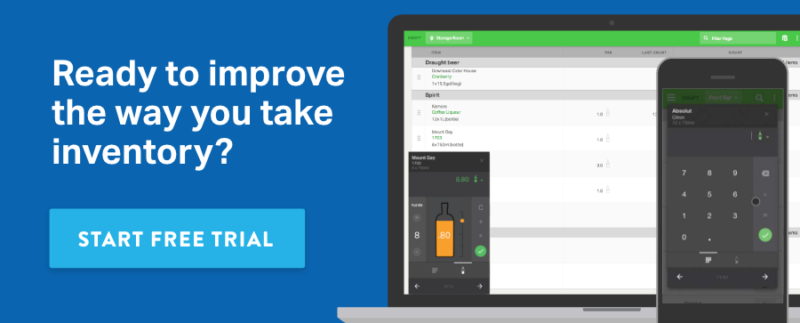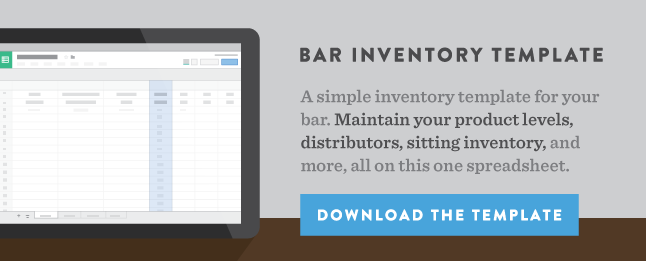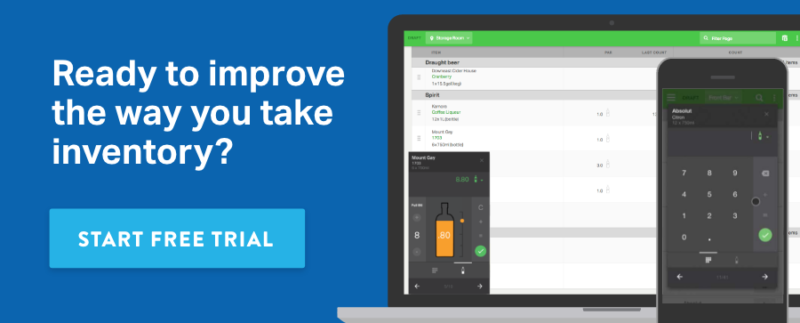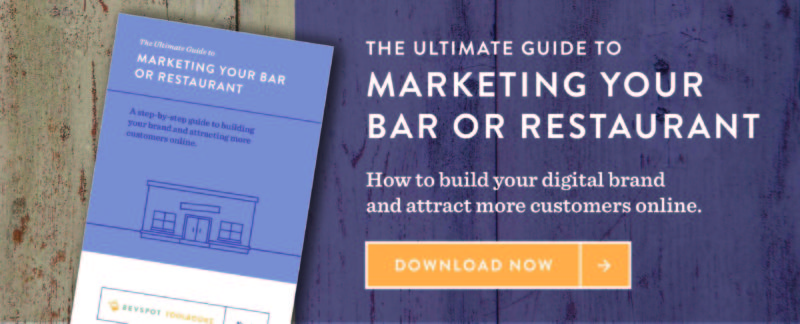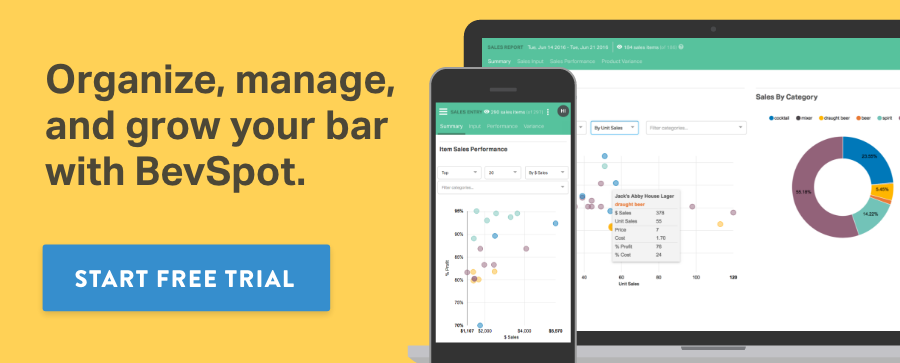6 Ways to Make Bar Inventory Faster
How to Make Bar Inventory Faster
Let’s face it, no one looks forward to taking bar inventory. It’s boring, it’s time-consuming, and it’s draining, especially if you’re counting at the end of a Sunday night shift. Even though it’s not the most desirable of tasks, as a bar manager, you know liquor inventory is a necessary part of running a successful bar.
If you’re taking bar inventory pen-and-paper style, you probably wish there was a way to make it faster. But before you consider taking speed counting classes, here are 6 ways to make the bar inventory process faster.
1. Have a system in place
When you receive a shipment, it shouldn’t look like the delivery truck threw up in your storage room. If it does, you’re going to have a very long night of counting inventory ahead of you.
To speed up the process, establish a system to make sure each product lives in a certain place. Organize your bar and storage room by item type and then by alphabetical order. For example, keep all your vodkas together, and arrange them from Absolut to Zytnia Extra.
Every time you replenish, be sure to keep your products in the same order as they are on your shelves. This will make it easier to arrange your workflow so you can quickly count down the line. If your items always live in the same place, you’ll decrease the chances of missing a product in your count.
2. Have an organized bar inventory spreadsheet (or software)
If you’re taking pen-and-paper inventory, create and print out an organized inventory spreadsheet. Arrange the spreadsheet in the same order as the products are organized in your bar and storage rooms. Your sheet should include the type of alcohol (e.g. beer, whiskey), brand (e.g. Samuel Adams, Glenfiddich), name (e.g. Boston Lager, 12 Year Old Scotch), bottle size (e.g. 12oz, 750ml), and total count. You can also make it easier by including your locations, such as front bar, back bar, walk-in, etc.
3. Train your staff to take inventory properly
If your staff doesn’t know your system for inventory, it’s definitely going to take a while, especially if you have to go back and fix mistakes.
Before you assign staff to take inventory, make sure they’re trained on the proper inventory process. Tell them whether you count left to right, or right to left. Explain how to use the “tenthing” process, and train them on how to properly report specific issues like spillage or breaking of whole bottles.
4. Assign multiple people to count
If multiple people count at once, you’ll be able to divide the labor and cut down your inventory time. Assign a certain area to each person doing the count to ensure there are no overlaps. For example, one person can count the front bar and the other can count the storage room. Having multiple people participate in inventory can also decrease the chance of theft.
5. Take inventory when the bar is closed
If you count when the bar is open, product might slip in or out while your count is in progress. If your product levels are changing while you’re counting, it’s going to mess with your accuracy, and you may find yourself starting over or backpedaling to fix discrepancies.
To fix this, make sure you only take bar inventory when your bar is closed. This way, you can focus all your efforts on getting the job done and won’t have to worry about fluctuations in product level.
6. Decrease your sitting inventory
Simply put, if you have a lot of sitting inventory, you have more product to count. Each bottle, can, and keg represents time required to count it each week or month. If you focus your efforts on decreasing your sitting inventory, you’ll also reduce the time required to take inventory.
Now that you have some tips for reducing your inventory time, we hope you’ll have more time to spend on the parts of the job you love. But no matter how hard you try, pen-and-paper inventory is still going to be a tedious and complicated part of bar management.
Want to really cut down your inventory time?
Start Your FREE Trial of our inventory, ordering, and sales reporting software to see what BevSpot can do for your bar.
Schedule a Chat BevSpot offers full product education and account setup for all customers! No card Information needed!
A Year of Data: Top Selling Spirits by Season
Intro
Last week, we looked at $20 million worth of orders placed through the BevSpot bar management platform. We broke down the data and identified which beverage/liquor categories sell best throughout the year: in spring, summer, autumn, and winter.
This week, we’re taking a closer look at seasonal spirit sales by specific category—to find out which spirits sell best (and which ones don’t) across the seasons.
The Results: “Top Selling Liquor by Season”
Portland Startup is Barrel-Aging Without the Barrel
You pour a customer a top-shelf whiskey. It’s a nice, caramel brown color. The customer raises the glass and smells spice and vanilla. He takes a sip—it’s smooth and hot with a woody flavor.
Most of whiskey’s color, scent, and taste comes from the barrel-aging process. Top-shelf whiskey is usually aged for 10 to 20 years, sitting in an oak barrel in a distillery. This barrel-aging breaks down the rougher flavors of the alcohol, makes it more smooth, gives it its brownish color, adds unique flavors, and filters out toxins that cause nasty hangovers. Due to the many years of aging and the natural evaporation of 30%-40% of the product, these whiskies can cost hundreds of dollars.
A startup in Portland is challenging the traditional mindset that oak’s flavor, color, and filtering in whiskey can only come from years of barrel aging. With specially designed pieces of oak wood called Whiskey Elements, they’re accelerating the maturation process, reducing the impurities, and improving the flavor of whiskey in less than 24 hours.
We had a chance to chat with David Jackson and Joshua Thorne, Time & Oak’s co-founders. Here’s what they had to say about what sparked the idea for the company, how the whiskey community responded, and the science behind their product.
How did you come up with the idea for Time and Oak? Was there an “Ah-ha” moment?
David Jackson: The original idea happened when we walked into the liquor store and asked ourselves a very simple question: “What’s the difference between top-shelf and well whiskey?” The answer came simply, “TIME & OAK.” That’s when it hit us—if the goal is for the whiskey to filter in and out of the wood, be infused with flavor, and develop those rich colors, then the barrel may not be the best design to achieve this process.
See, a bottle of moonshine or un-aged whiskey can sit on a shelf for years without any real change to its taste. However, if it spends that time in a barrel, you will see rich flavors and colors develop. Aging is not so much about the time. It is about the craft, the wood, and the spirit.
Was this something you thought about for a while?
David Jackson: Our idea came quickly. That said, deciding how to deliver it was pondered, researched, and experimented with for nearly a year leading up to the formation and launch of our first product, the Whiskey Element.
Once you had the idea, how did you get started?
David Jackson: In July 2014, Joshua and I decided to go ahead with this idea and turn it into a company. Time & Oak was incorporated on August 6th, 2014. In just under two months after its inception, the Whiskey Element was announced on October 1, 2014 via Kickstarter.
How long did it take you to come up with the final product?
David Jackson: After arriving at the true concept, my co-founder, Josh Thorne, went to work cutting, burning, and cooking all kinds of oak. The process of finding the right temperature and time for the wood, as well as the best way to expose the capillaries, took about three months. During that time, we held hundreds of blind tastings resulting in a definitive crowd winner: The Signature Element was born.
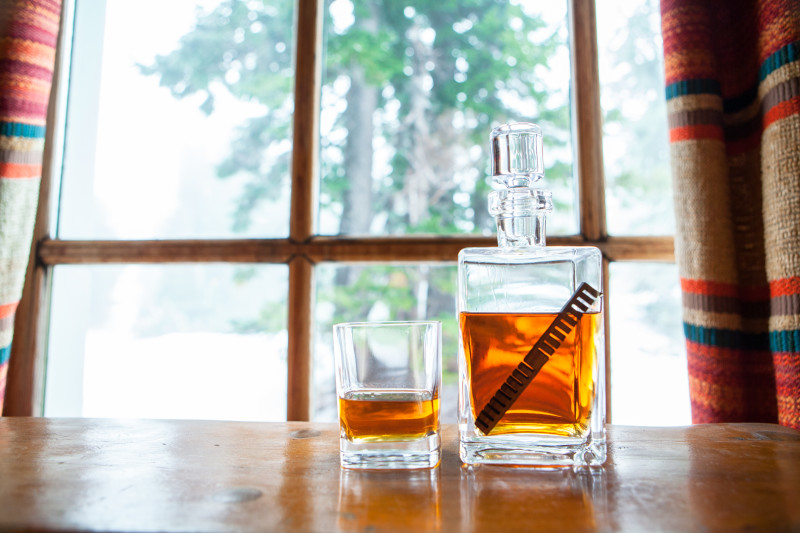
What kind of challenges have you run into during this journey? How did you overcome them?
David Jackson: We have faced most of the challenges any new startup would: growing and finding office space; hiring the right team members; working on a shoestring budget; long hours, cheap pizza, and great jokes shared by those in the office along the way. Our greatest challenge has probably been overcoming the misunderstanding of our product. People think it can’t work or is some kind of gimmick, and they often label us before they know us or give us a try. We source and create our Whiskey Elements with the same materials and methods of traditional whiskey companies. We just make it easy and convenient for anyone to access the beautiful flavors of barrel aging.
To date, we have held over 40,000 taste tests, with amazing feedback. It is in letting people taste the difference one at a time that we’re winning hearts and opening up people to this long tradition. We’ve been recognized by huge industry names, including the National Brand Director of Whiskeys at Bacardi and the President of 1921 Tequila. But of course they had to be willing to try it first, and not just once.
Experimenting with Whiskey Elements should take place multiple times and in various spirits. People should treat the Element like they would a barrel; if you want a dark rum type finish on a sprit, place the Element in dark rum briefly before using it. Get creative and really explore the possibilities—they’re endless.
Do you have any type of science background?
Joshua Thorne: I enlisted in the United States Air Force in 2005 and spent four years working in Aerospace Mechanics. After a trip to Iraq and a few stories to tell, I finished my four-year commitment and started writing and making films. In 2010, I sold my first film to Lionsgate that I wrote, produced, financed, and even acted in myself. Working in the film industry really allowed me to be creative. After selling my film, I was ready for a new adventure. I really wanted to start a small business.
The inception of this idea came from my business partner Tony Peniche. After his initial pitch, I instantly identified multiple hurdles with the concept, but I also felt they could be overcome. So I dove into the science of barrel-making and how the wood interacts with the spirit to accomplish such great flavor. After a few months, the Whiskey Element was born.
Where do you source your oak?
Joshua Thorne: Trade secret. Literally. I can tell you it comes from the Midwest, and it’s one of the main places that barrel makers get their barrel wood today.
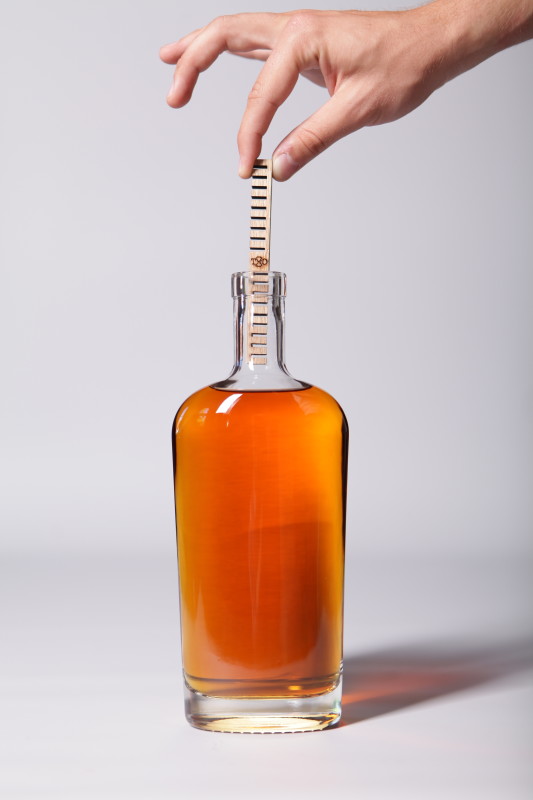
What other materials are used in Whiskey Elements?
Joshua Thorne: Nothing! Our product is 100% Natural American White Oak. The flavors you get come naturally from within the wood. Different temperatures unlock different flavors.
Why does removing certain toxins prevent a hangover?
Joshua Thorne: Acetaldehyde is a chemical that naturally exists in alcohol. It’s also a leading cause of hangovers. The organic wood and charred surfaces act as a natural filtration device. The wood actually bonds to Acetaldehyde, keeping it from the alcohol and limiting the amount a person will drink.
Can you use a Whiskey Element more than once? If so, how many times?
Joshua Thorne: Officially, no. Unofficially, yes. I say this because after the first use, all the vanillins, sugars, and tannins will be removed from the wood and imparted into the spirit. So the second use will have a diminished return. But if you want to drop it into a wine for a few hours and then throw it into a bottle of rum to create your very own thing, go for it. Some people really like moving it from a whiskey bottle to a tequila.
You say Whiskey Elements help people drink whiskey the way they want to drink it. Can you explain how customers can alter whiskey’s aspects?
Joshua Thorne: Without American Oak, there is no whiskey! Well, aged whiskey. Un-aged whiskey is clear. It’s often called moonshine, white lightning, or fire water. But whiskey, as we know it, is brown and beautiful. Many distillers agree that up to 80% of the flavor, color, character, and aroma comes directly from the wood. But this process takes many years. With our Elements you can have that reaction in as little as 24 hours. We have far greater surface area and interaction with the wood than a 52-gallon barrel does. Now, you can replicate this process at home, but with a tool that is far more effective and a cost that is much more reasonable for the typical consumer.
How are customers using your product? Are they using them in other types of liquor?
David Jackson: We get emails from people all the time. They’re using Elements in a way we hadn’t anticipated, which is awesome. We didn’t realize how many culinary applications there could be. One lady told us she uses them for home canning. Another customer said he uses Whiskey Elements to add a kick to his homemade BBQ sauce by soaking them in Jack Daniels and then soaking them in his sauce. One of our restaurant accounts, the Edgewater Hotel, in Seattle, ages their balsamic and olive oil with Whiskey Elements.
The Elements are also going beyond just whiskey. People are exploring with tequila, wine, vodka, and beer. They’re also cross-infusing liquors by putting an element in one type of alcohol and then putting it in another.
How do you suggest bartenders use Whiskey Elements?
David Jackson: Mixologists know how to use Whiskey Elements because they’re creators. They’re passionate and they know how to experiment, taste, test, and use the Element as a finishing tool. With our product, they have the ability to create a variety of unique, barrel-aged flavors only found at their bar or restaurant, and they can make it quickly and turn it over again.
Vodka, such as Tito’s, aged with an Element, is great for making Bloody Mary’s or Moscow Mules. The taste is unique and delicious. Think about it—for centuries, oak has been a key flavor in alcohol. We use wooden oak barrels in so many applications, like creating the perfect balance in a fine wine or finishing our favorite spirits like tequila, rum and (of course) whiskey.
Whiskey Elements are great for bars because of their convenience and cost. Let’s say you sometimes make small batches of barrel-aged spirits or cocktails, and it takes 42 days to make 30 cocktails. If you use a Whiskey Element instead, it can take a total of 4 days to make 30 cocktails, and it would cost you a fraction of the price.
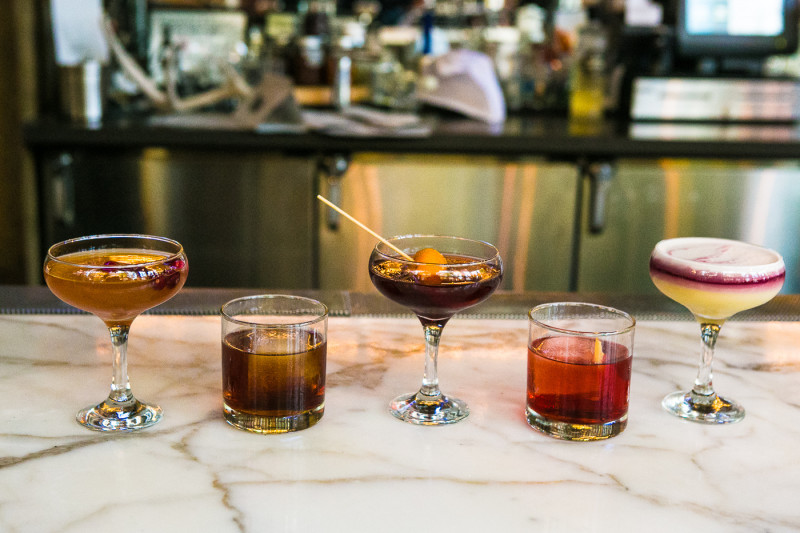
Do any bar programs currently use your products?
David Jackson: Right now, we’re partnering with a bunch of restaurants. 23Hoyt, Pope House, Private MAC club in Portland, and the Edgewater Hotel in Seattle all create featured cocktails using Whiskey Elements. For example, Nick Perdue at 23Hoyte makes the “Lewis & Clarke,” one of my personal favorites, with Whiskey Element-aged rye whiskey. Colby Hayden at the Private MAC club makes a “Grumpy Margarita” with 2oz. of Whiskey Element-aged “Grumpy” tequila. We’re also now working on a cocktail program for Houlihan’s Restaurant and Bar.
When we originally released the product, it was a consumer product. We signed a deal with Safeway and other national retailers. Now, we’re planning on targeting restaurants, bar owners, and cocktail programs.
What’s your favorite Whiskey Elements + whiskey creation?
Joshua Thorne: Everyone in the office has their own favorite, and our customers find theirs daily. For me, it has to be Crown Royal and our Signature Element. After about a day, it become really smooth and the sweetness is ramped up. I can’t stop showing it to guests when they come over.
Any last thoughts?
David Jackson: Basically, we’re lifting up the skirt on the whiskey industry. We’re helping people understand the important role wood plays in creating many of our favorite flavors. Just like the distiller starts with an amazing base spirit, we want you to do the same. Start with what you love, something worth making your own and appreciating.
For years, someone else has set the standard for what makes a “good” spirit. Yet, there are countless spirit varieties and ways to enjoy them. It shouldn’t be about what’s right and wrong, but about what spirit you like and how you want to enjoy it. We have such a deep respect for whiskey and its tradition; we want to continue that tradition by giving people access to create an all natural and unique taste. A taste that can only be achieved with oak, after all time and oak are fundamental to the flavor of many of our favorite spirits.
What does the future look like?
Joshua Thorne: Robots, flying cars, time travel, and good whiskey! In all seriousness, we’re looking at the long-standing popularity of aged spirits, particularly whiskey, and our love for it. Unfortunately, both our product and the barrels many distilleries use are crafted from limited tree strands. By encouraging efficient use of wood with Whiskey Elements, and by being a zero-waste manufacturer, we can both conserve and prolong access to crafting delicious aged spirits well into the future.
In order to ensure conservation of wild lands, we have also partnered with Project Footprint, an organization that protects and conserves wild lands.
Oak has been used for thousands of years to store food and transport various goods and liquids. The unique flavor of oak has a certain place in our palate as well as our history. We want to revive and continue the tradition of barrel-aged flavor and quality well into the future, and, for the first time, in a very convenient way. Ever wondered what barrel-stored olive oil tastes like? Create one at home, much like the Edgewater hotel in Seattle has done for their guests. What we have learned thus far is that the future for Time and Oak is bright and the uses for our product lines are limitless.
Here at BevSpot, we share a similar mindset. The alcohol industry is rooted in traditional practices, such as barrel aging and pen and paper inventory. Traditions will always be an important and respected part of our industry, but innovation, whether it’s laser-cut oak or bar management software, can help us to improve and advance the space.
Are you ready to get innovative? Use Whiskey Elements as a finishing tool to create signature drinks while using BevSpot’s bar management software to reveal insights, save time, and increase profits. Want to know more about BevSpot? Visit our retailers page. Interested in Time & Oak? Check out their website.
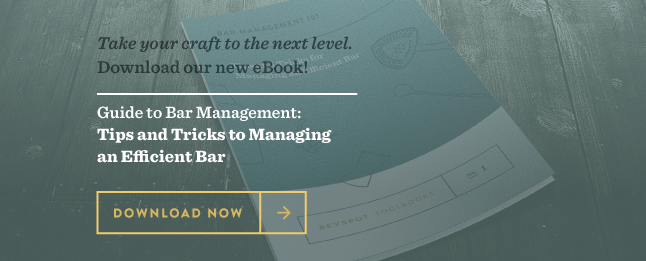
Why You Should Think About Bar Inventory in Weeks
Give Your Inventory More Context
Taking bar inventory is essential for running a successful bar. From hundreds of conversations with bar managers and owners every week, we’ve realized that the industry standard for thinking about inventory is in units or dollars.
While these are useful numbers to track, measuring inventory this way leaves you with a number of questions. For example:
- Is your sitting inventory level too much, too little, or just right?
- How does one category or item type’s level of inventory compare to another?
- If I own multiple locations, how do I measure inventory performance across them?
As a result, a great supplemental way of thinking about bar inventory is thinking beyond just the dollars and units and diving into inventory efficiency, or a balance of inventory levels.
Calculating weeks’ worth of inventory is a great method for determining inventory efficiency and providing significantly more context to your inventory numbers, especially when comparing multiple product types and locations.
Think Efficiency, Not Dollars
Thinking about inventory in terms of efficiency is a fundamental first step in effectively managing it. You might know how much your inventory is worth, but do you know how many weeks’ worth of usage that inventory represents?
To calculate weeks’ of inventory, use the following equation:
Sitting Inventory ÷ Average Weekly Usage = Weeks’ of Inventory
The basic goal for inventory management is to have enough inventory at any given time to support predicted sales until the next delivery and provide an additional cushion for potential sales spikes and late deliveries. By thinking about inventory in weeks instead of dollar value, you can directly link inventory levels to planned sales and focus on maximizing your return on investment.
Really think about how much of your cash you’re committing to inventory. Remember, this cash is just sitting on the shelves and can’t be used elsewhere. By thinking about inventory in weeks, you can more accurately project what inventory you can actually expect to sell.
Use Inventory Efficiency To Benchmark Your Business
Sitting Inventory
| Rhonda’s on the Beach | Iguana Rick’s | |
| Beer | $5,000 | $5,000 |
| Wine | $6,000 | $3,000 |
| Spirits | $4,000 | $4,000 |
| Total | $15,000 | $12,000 |
Imagine you own and manage two bars: Rhonda’s on the Beach and Iguana Rick’s. At first glance, these bars might seem to be pretty similar. Their sitting inventory is listed in dollar amounts, and it looks like the only difference is that Iguana Rick’s has half the wine inventory of Rhonda’s on the Beach.
Average Weekly Usage
| Rhonda’s on the Beach | Iguana Rick’s | |
| Beer | $1,000 | $2,500 |
| Wine | $2,000 | $500 |
| Spirits | $1,000 | $500 |
| Total | $4,000 | $3,500 |
When you factor in average weekly usage and determine your weeks’ of inventory, you can give context to your inventory numbers. For the above example, although the sitting inventories are similar, we can divide by the average weekly usage to calculate inventory in weeks. This way, we can see which category levels are overstocked and take actionable steps to decrease them.
Bar Inventory in Weeks
| Rhonda’s on the Beach | Iguana Rick’s | |
| Beer | 5 weeks | 2 weeks |
| Wine | 3 weeks | 6 weeks |
| Spirits | 4 weeks | 8 weeks |
As an owner/manager of multiple establishments, based on the recommended 2-3 weeks worth of sitting inventory per category, you can now conclude the following:
Rhonda’s on the Beach
- Beer inventory is overstocked by two weeks
- Wine inventory is optimal
- Spirits inventory is overstocked by one week
Iguana Rick’s
- Beer inventory is optimal
- Wine inventory is overstocked by three weeks
- Spirits inventory is overstocked by five weeks
If you had measured sitting inventory by dollar value, you might have come to the unsupported conclusion that Iguana Rick’s was running a more successful wine program. But, by thinking about inventory in weeks, you can now see that Iguana Rick’s wine inventory is overstocked by three weeks’ supply.
By comparing the inventory performance of both establishments, you can see the inventory levels of Rhonda’s on the Beach are generally more balanced than Iguana Rick’s. This means your first focus should be reducing Iguana Rick’s wine and spirits inventories. After you’ve balanced these inventory levels, you should focus your efforts on reducing Rhonda’s on the Beach’s beer and spirits inventory.
Increase your cashflow
If you have less sitting inventory, you have more money in your pocket. By limiting your ordering and understanding how many weeks’ worth of supply you’re sitting on, you can bring your inventory levels down to 2-3 weeks’ worth.
Remember, every dollar you spend on inventory is a dollar you can’t put towards other costs like payroll and marketing. Plus, product can be stolen, broken, or spilled. Sitting on 10 weeks’ worth of inventory isn’t as safe as having that cash in the bank. By decreasing the amount of product, you have sitting around, your money will be more secure.
The next time you think about inventory, think about it in weeks. When it comes to managing inventory, efficiency is a better indicator than dollar value. If you understand the weeks’ worth of supply that each category of product represents, you’ll be able to take active steps to reduce your inventory levels and increase your cashflow.
We’re here to help you run a better business and find out what BevSpot can do for you!
Schedule 15mins to chat with a product specialist
Start a FREE Trial Today! BevSpot offers full product education and account setup for all customers! No card Information needed!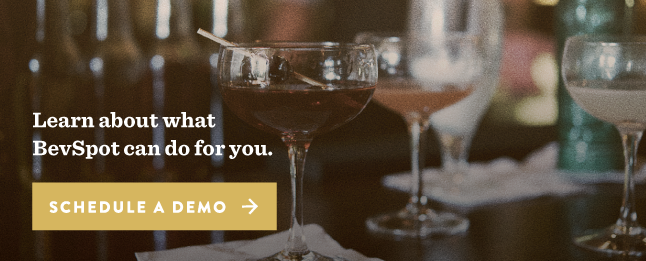
A Year of Data: Beverage Sales By Season (2015-16)
Featured Article: The Most Popular Beer & Liquor Brands of 2018
Spring, summer, fall, winter. Which beverage categories rule the seasons?
We recently analyzed 12 months of beverage orders placed by our customers. Our product team took a look at beer, wine, and spirit sales and how they fluctuate throughout the year. Which category is the most popular in summer? What about winter? See the results below.
(For an updated look at these trends, check out our 2017 edition.)
Spotlight on Mystic Brewery
What is Mystic Brewery
The minds behind Mystic Brewery of Chelsea, Massachusetts draw from historical brewing methods to produce beer with a focus on fermentation and locally sourced yeast. The brewery’s founder, Bryan Greenhagen, has a background in industrial fermentation, product development, and homebrewing. He founded Mystic Brewery in 2011 after his postdoctoral studies at the Massachusetts Institute of Technology.
The brewery opened to the public in 2013, but it didn’t always have its own brewhouse. Greenhagen and his team aged beer in square wine fermenters and barrels in the back of the building and brewed beer at another location. About a year ago, Mystic purchased brewing equipment from Vermont’s Hill Farmstead Brewery and started brewing their beer in-house. Now, Mystic is able to experiment with more beer varieties, such as double IPAs and sour beer.
A great brewery is built on great beer, but it also needs to have a strong brand presence, a social media following, great marketing, creative label designs, and positive distributor relations.
This is where Louie Berceli comes in.
We had a chance to chat with the Mystic Brewery Sales and Marketing Manager/In-House Designer to get an inside look at the brewery operations that don’t include beer brewing. Here’s what he had to say about his role at the local Massachusetts brewery.
When did you start working with Mystic Brewery?
I started in February of last year. Before that, I was doing the purchasing for a wine shop out in Brookline. For a while, I was technically working with the brewery, just on the other side of the counter.
What’s your favorite thing about Boston?
I like how small Boston is. It’s a microcosm of all the best things in any city, but it’s all within walking distance.
Were you always interested in working with beer?
I studied English in college, and I figured I’d do publishing for a while. But, I was laid off at a publishing company in New Hampshire, and I ended up taking a job at a liquor store. My job there made me realize I was way more passionate about beer than I thought.
Describe your role at the brew house.
At the brewery, I do sales marketing and design. This means I arrange orders with distributors in Massachusetts, New York, and all different importers. It’s my job to make sure our beer gets to the right accounts. I also handle all PR and social media responsibilities, and I do the label designs as well as all the miscellaneous design the brewery needs.
Do you have a favorite design you’ve done for the brewery?
I’ve had a lot of fun with custom-made hats and shirts. But I’d probably say my favorite design is the Saison Renaud label. It was really intimidating at first, because the old label was iconic. I had to approach it carefully and respectfully, but update it to look more modern.
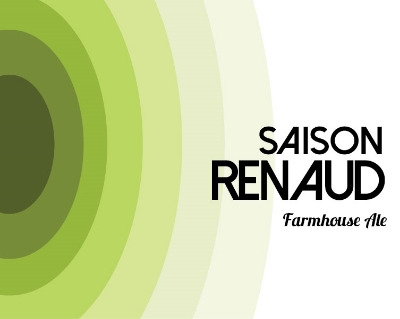
What’s a visit to the tasting room like?
We have regular tours on weekends, and we also have a weekly trivia night, jenga sets, and a dart board. We offer a full menu from Ciao Pizza and Pasta—they’re right next door and they function as our kitchen.
Mystic is cool because we’re trained to run the tasting room like a neighborhood pub. We don’t want it to be a formal tasting environment, just somewhere you want to go regardless of whether you’re touring breweries or not. During the week, it gets pretty busy, but it isn’t as intense as it is on the weekends. Every brewery I go to is filled with guys who look like me, which is pretty disappointing. At Mystic, it’s filled with Chelsea locals.
What social channel do you think is most important for Mystic?
I would probably say Instagram. It’s a quick, easy way to announce new releases and show a day-to-day slice of life. Customers are becoming more visual-based. I use the VSCO app to edit my pictures and then upload them. I have a $700 camera at home, but the iPhone works great, so I just use that.
Twitter is a close second channel because of how concise and immediately effective you can make the message. It’s a place to take things a little less seriously and make more jokes. I’ve also been debating making a company Snapchat, but we’ll see…
Beer isn’t always the answer, but we don’t ask those sort of questions.
— Mystic Brewery (@MysticBrewery) December 8, 2015
What industry publications do you read?
I read Beeradvocate pretty often. I’m also a really big fan of this blog called Good Beer Hunting—it’s one of the first blogs I started reading, even before I was directly involved in the industry.
What’s your favorite Mystic beer?
I’d say my favorite is Flor Ventus. It’s a wild ale fermented with a mixed culture of wild yeast. It fermented for almost five years in chardonnay barrels and finished in the bottle for an additional year. I also like a good table beer—you can’t beat that for day-to-day.
What six beers would be in your perfect variety pack?
Hmm, that’s a good one. I would say Tree House Julius, Trillium Stonington, Cantillon Rose de Gambrinus, 3 Fonteinen Oude Gueuze, Oxbow Blended Oxtoberfest, and BFM Abbaye de St. Bon Chien.
Mystic Brewery specializes in farmhouse-style ale. Can you explain what this style’s like?
It’s a historic Belgian style, originally brewed to keep the farm hands hydrated. They’d keep it with just enough alcohol to kill anything, but not enough to make you pass out. It has a dry peppery finish. If I’m being lazy on food pairings, I default on a saison.
What makes Mystic beer different?
Probably our yeast. Our founder studied fermentation science at MIT before he started here. We have kept our house strain of yeast since 2010, when we opened. It keeps building flavor and finishes the beer drier every time. I also think our Vinland Series is unique. We find wild strains of yeast throughout New England and brew with them.
Where is Mystic beer available?
It’s available in Massachusetts and New York. Shelton Brothers Imports is our main distributor. For the most part, we’re available nationwide but in smaller quantities. We’ve also been working with some one-way kegs so bars don’t have to ship them back. Out of the U.S., we ship to England, occasionally to Denmark, and I think we may have shipped to Japan once.
Are there any cocktail recipes that include Mystic beer?
I don’t know of any just yet, but I’ve been hoping someone will use Entropy. It’s an uncarbonated beer made with sherry yeast, and sherry is a seriously fun ingredient to work with in cocktails.
Do you sell any specialized glassware?
In the tasting room we have tulips and traditional pint glasses. I personally think the best beer glass is a red wine glass. It retains the aroma and the stem helps to maintain the temperature. We don’t use them in the taproom, though. They’re too fragile.
See the Ultimate Glassware Guide for Beer Enthusiasts.
How can bar, restaurant, and liquor store owners schedule a tasting with you?
We’re trying to keep tastings to a minimum right now because demand is up and we’re still really small. You can count the amount of employees we have on one hand. If people are looking, though, they can email me: Louie@mystic-brewery.com.
As you can see, there’s a lot that goes into running a successful brewery (much like running a successful bar). Mystic Brewery can be found in select bars and restaurants across the country. If you’re from the Boston area, be sure to stop by the taproom for a pint! If you’re looking to stock your bar with some of Mystic’s quality brews, email Louie@mystic-brewery.com.
Here at BevSpot, we love being able to shine a light on the industry’s most interesting producers, creators, and innovators. Interested in more articles like this? Subscribe to our blog!
Schedule 15mins to chat with a product specialist
Start a FREE Trial Today! BevSpot offers full product education and account setup for all customers! No card Information needed!
Can Alcohol be Healthy?
Find out the key ingredients to developing healthy cocktail recipes.
Cocktails are delicious, yes. And we continue to love and create them despite the damage they do to our bodies. But what actually happens when alcohol hits the body? What influences the effects of alcohol? And what if, with new ingredients and techniques, we could make healthy cocktail recipes that are great for both our health and our tastebuds?
Last month, at the Charleston Wine and Food Festival, we sat down with Pam Wiznitzer of Seamstress NY and Megan Deschaine of 492 Charleston for a conversation about the health benefits of certain alcohols, the ingredients that manipulate the bodily experience, color and edible components, and dual-application ingredients.
If you’re looking for healthy cocktail recipes to add to your menu, you first need to understand three things:
- What kind of alcohol you’re using
- The effects of this alcohol
- What supporting ingredients should (or should not) be used
We asked Pam and Megan if alcohol can really be healthy. Or, at the very least, if it’s possible to make healthy cocktails. Wait till you see what they told us.
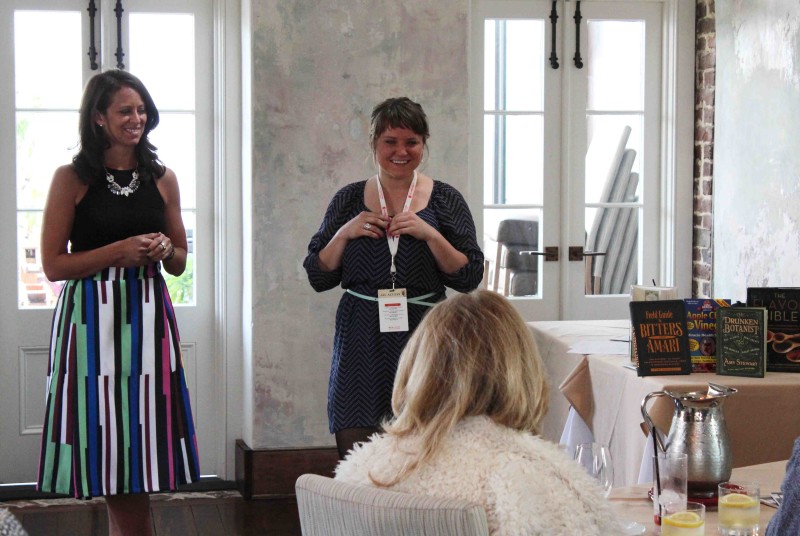
What influences alcohol’s effect on the body?
For the last few years, Pam has been researching the science behind booze. We asked her what alcohol does to the body once consumed.
“There are several factors that affect why and how you get drunk,” says Pam. Most drinkers are aware of these factors, but here are the biggest ones:
- Sex. “It’s not physically possible for women to keep up with men while drinking,” Pam explains. As a general rule, men have more muscle content and women more fat. Muscle retains water better than fat does, and water is going to help break down alcohol, which is why men can drink more alcohol, faster.
- Body type. We all have different body types with different muscle-to-fat ratios, and thus our bodies process alcohol in different ways and at varying rates.
- Age. As you grow older, your metabolism changes and starts to slow down, which means it will process alcohol at a slower rate. “And it’s only going to get worse as you get older,” Pam laughs.
- Absorption rate. It’s important to prepare your body in the hours leading up to a drink. “We all know we’re supposed to eat a big meal before we go out. The more food in your stomach and the more hydrated your body is, the slower rate of intoxication due to slowed absorption,” says Pam.
- What your drink is made of. We all know a shot equals a beer equals a wine, but the effect still varies. “If you’re drinking anything with bubbles, it will hit the inside lining of your stomach faster because of carbonation,” Pam explains. Therefore, you’ll feel the effects of the alcohol faster. “The same goes for drinks like Redbull and vodka—it’s caffeine alongside carbonation and alcohol. It may have the same volume of alcohol as a regular cocktail, but of course it’s going to wind you up faster!”
- What liquor you’re drinking. “Has anyone ever felt a little crazy after drinking tequila or mezcal?” Pam asks. “When a grain (like the ones whiskey is made from) enters the body, it’s seen as a toxin and attacked by the body. But tequilas and mezcals are made with agave plants (and, as another example, brandy is made with fruit). Anything that’s produced with vegetation is identified by the body as a source of energy, and your body will use it instead of attacking it, thus processing the alcohol faster and in a different way.”
Is there a cure for the hangover?
We now know the factors that affect how and why we get drunk. But before we discuss the key cocktail ingredients that might make healthier alternatives, let’s look at how alcohol does its damage.
About 20% of alcohol is absorbed through the stomach, and 80% through the small intestine. The alcohol then flows through the bloodstream. Approximately 90-95% is processed by the liver, which is why you need to take such good care of this organ. The remaining 5-10% is excreted through urine, breath, and sweat. But what you’re consuming, and the rate of consumption, is going to heavily affect how the toxin is both used and removed by your body.
We’re all aware of what happens when we drink too much, yet, for some reason, the notion of the hangover always lingers in the distance, only to appear when it’s too late. Here are some quick and dirty tips that might help.
- Vitamin B. “I can’t tell you how important it is to have excessive amounts of vitamin B before you go out or the next morning,” says Pam. Vitamin B is removed through the liver alongside the alcohol, so one vitamin B complex tablet will restore these levels.
- Potassium. “Bananas are a huge cure-all. Have one before or after drinking, and I guarantee you’ll feel 10 times better,” says Pam.
- Water. Everyone knows this one, but it couldn’t be more important. “For every drink you have, you should be drinking a whole glass of water. And it’s better to drink something on the rocks because it’s diluted,” says Megan.
- Overall health and wellness. The general process for how you treat your body will also affect the way you feel in the morning. The healthier you are, the faster your metabolism will work, allowing your body to easily process all those bad things you feed it.
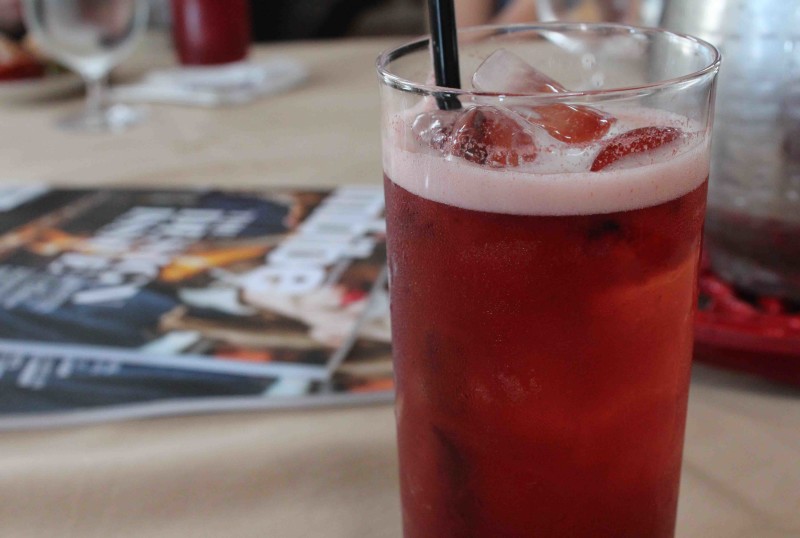
Developing Healthy Drinks
Brushing aside these quick fixes, Pam and Megan swear by one overarching theme when it comes to balancing alcohol with health.
One word—quality.
“We always try to use the highest quality ingredients,” says Megan. That’s the secret to the perfect cocktail. Better quality ingredients mean better tasting drinks that are better for you. Not all ingredients or spirits are made the same.
These days, bartenders are putting as much thought and dedication into creating their menus as any Michelin starred chef would. “Distillers are working hard to improve the quality of their products, and a lot of research is being done by the bars who care,” says Megan. “There’s a lot being done to improve environmental and manufacturing ethics, but it’s you who’s consuming the produce, the flavors, and the health benefits, so it’s you who has to care about the quality.”
Think about the spirits you’re using at your bar. “Don’t buy spirits packaged in plastic. The product is probably stretched out and likely loaded with parts of the distillate that aren’t meant to be consumed,” says Megan.
So, apart from maintaining quality, what else can we do to make our cocktails healthier?
Check out our free Drink Price Calculator.
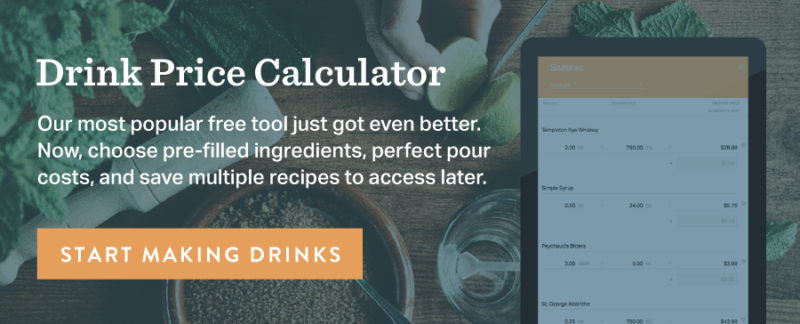
Key ingredients for a healthier cocktail
“Fortunately, we’re past the era of people using pre-made sours mix, which is basically just corn syrup,” says Pam. More bartenders are trying to add higher quality ingredients to their cocktails to provide something that’s better for their customers’ bodies than Rose’s lime juice or a simple syrup made of bad sugars.
So, when developing a new cocktail, it’s important to consider what’s really going into it. Are you using fresh ingredients? Are the spirits high quality?
These are the cocktail ingredients that Pam and Megan recommend.
Citrus
As long as you use fresh fruit, you’ll find high amounts of vitamin C, calcium, and folate in citrus juice. There are great benefits from eating the entire fruit, so think about how you can use the whole thing. “Save the rind and dry it out to make candied orange peels!” Says Pam.
A classic application of citrus is in punch, where you’ll use the zest of the citrus. “Also, if you let citrus zest sit with granulated sugar for a few hours, the sugar will extract the oils, creating something that’s delicious, bright, and sweet. Plus, you’re getting maximum use out of that fruit,” says Megan. “Do this process with lemons, and you’re halfway to making limoncello.”
While not a citrus fruit, apples are an underrated ingredient. “They’re high in sugar, but the sugar is natural. You get a lift in your mood, a boost in vitamin C and antioxidants, and the fruit is cheap and accessible,” says Megan.
Berries
“I love berries as a cocktail ingredient, and, for me, the blackberry is king—it’s the highest antioxidant berry there is,” says Pam. “Black currants are also really good for you,” she explains. “Try adding black currant liqueur to a bit of champagne—delicious.”
Blueberries are a known superfruit, loaded with nutrients that prevent and fight brain cancer. “Take your mojito and muddle in some blueberries!” Megan suggests. Pam likes to take advantage of fruits when they’re in season, so she makes her own jam when berries are in bloom and uses it in her cocktails throughout the year. “It’s the easiest way to bring back flavor that you can’t get seasonally, and you’re controlling the sugar levels and maintaining the quality of your drinks year-round.”
Teas
Tea and alcohol have a historical relationship, dating back to a tradition when women incorporated booze into their diets through tea, mostly for alcohol’s “medicinal qualities”. Also, punch was originally made with tea instead of water because it adds all the flavor and nutrients without diluting and then adding the spices. “In my cocktails, I often use chai tea for its lovely cloves, cinnamon, and spices. Everyone loves it!” says Pam. Here are some other favorites.
- Green tea, one of the most widely known health-beneficial teas, has a high concentration of EGCG (a type of catechin used in most dietary supplements and found in certain superfoods), and has been proven to lower the risk of lung, stomach, bladder, breast, pancreatic, and colorectal cancers. It helps the body burn fat, unclogs the arteries, relieves stress on the brain, reduces the risk of stroke, and improves cholesterol levels.
- Black tea is a great source of natural caffeine, and has been proven to reduce the risk of stroke and lung damage.
- Rooibos (red) tea is made from a fermented herb from South Africa. It’s light, fragrant, non-caffeinated, and a great mixer for any spirit.
- Yerba Mate is a traditional, earthy, South American tea that’s high in natural caffeine. Mate is proven to be good for the metabolism and good at fighting cancer of the brain and mouth.
Vinegar
On its own, vinegar sounds unappealing, but there are thousands of uses for vinegar as an application to health. Primarily, it aids digestion and proper functioning of the intestines and organs, so vinegar in cocktails has huge health benefits.
“For me, apple cider vinegar is the superior vinegar of choice. Its flavor is the best, and it’s proven to be more beneficial to your health. Vinegars are easy to make, great for your health, and in cocktails they make a great substitute for citrus—they taste so bright and zippy,” says Megan.
She also mentions the use of shrubs and gastriques. “These are basically vinegar syrups with a long shelf life. You can take those berries and make a shrub, and have it in your fridge for 3 – 4 weeks. Add rum and soda water, and that’s a delicious and healthy cocktail,” she explains. The same goes for homemade bitters and tinctures—making them yourself allows much more flexibility in creating healthy cocktails.
Eggs
Pam has a flip on her menu at Seamstress, which uses the whole egg. “You can eat raw egg! It’s totally cool. We add balsamic vinegar to raise the acidity level and give it a kick,” she says. Adding whole eggs or egg whites to cocktails builds substance and sustenance, making the drink more filling and boosting its protein levels. “Much the same as using cream in cocktails, eggs stimulate a part of the brain that reacts to food and being fed, and the alcohol is easier to process,” she says.
Amaro
There’s a reason why Italians often start a meal with an aperitif and end it with an amaro. Amaro is a bitter, low-proof spirit. “It’s great for settling stomachs, and because it’s made from different herbs or plants, the botanicals not only add a great bitterness to drinks but provide a lot of nutrients to the body,” says Pam.
“Fernet Branca is essentially a healthy alternative to Jagermeister. The San Francisco bartenders revived it, and now it’s known as ‘the bartender’s handshake,’” laughs Megan. It’s an exciting time for amaro and sherry, which are being used by some of the best bars in the country right now. “Campari, sweet vermouth, and soda water is a delicious and healthy way to start the night,” she says.
Vegetables
There are plenty of ways to incorporate vegetables into your cocktails. From blending to infusions and even sous-vide, adding vegetables to a drink will significantly boost its nutrient levels. Think beyond the Bloody Mary, and try experimenting with things like beets, carrots, and kale.
Simple Syrup
Pam and Megan both agree that no bar should ever buy simple syrup. “It’s so easy to make—half sugar, half water, a tiny bit of vodka to fortify it, shake it up, and you’re done. It’ll last 3 – 4 weeks in the fridge,” says Megan.
“Sugar is one of those things that people are afraid of the most, but it’s not actually that bad for you; it really depends on the type and quality of sugar you’re using.” It’s easy to make syrups healthier when they’re homemade. And this rule goes for just about any ingredient.
Want to get even more innovative with your syrups? “Boil some chai tea, add an equal amount of sugar, and you have a chai tea syrup. Genius. You can do this with ginger, rosemary, sage, thyme, berries, almost anything. Take half an ounce of that, add an ounce of vodka and some club soda, and that’s a refreshing, low calorie way to drink healthier,” says Pam.
So, what’s their advice for mixing the ultimate healthy cocktail?
“I think about what I like to eat,” says Pam. “I start with a baseline, with one ingredient. I think about those inherent flavors and what flavors I like together, and I try to produce that in my cocktails. It’s also important to find relatable ingredients based on the same gene families. Doing so extracts more flavor and will allow you to cook or mix seasonally.”
We’re feeling pretty thirsty right now.
For more tips about crafting the perfect cocktail, check out our Cocktail Recipe Video Series.
Need some help running your cocktail bar? Download our free eBook: Guide to Better Bar Management.

Schedule 15mins to chat with a product specialist
Start a FREE Trial Today! BevSpot offers full product education and account setup for all customers! No card Information needed!
A Year of Spirit Sales Data: Top Selling Liquors
Find out which brands and types dominate spirit sales in the U.S. beverage industry.
BevSpot’s bar management platform recently hit $20 million in orders, so we decided to look at every order placed during the last year, and the results are in. Here are the top 7 best selling liquor categories. You might be surprised by the breakdown by alcohol type.
Take a look at the graphs to see how your bar compares.
16 Instagram Accounts All Bartenders Should Follow
16 bartender Instagram accounts you should be following.
Trying to come up with an intriguing cocktail garnish? Need to add a few spring drinks to your menu? Want to stay up-to-date with microbrew culture? You should definitely be on Instagram – the best app, next to our restaurant inventory app of course. Instagram isn’t just for posting selfies and viewing pictures of pretty landscapes. You can also use it to discover beautifully captured drinks, mixology inspiration, information, and recipes. To help you stay on top of all thing’s alcohol, we’ve compiled a list of 16 bartender Instagram accounts you should be following.
Start Your Free Trial With Bevspot Today!
1. StirandStrain
If you’re looking for some quality drink ideas, you should follow StirandStrain. The account’s admin, Elena, posts a variety of booze-related content, including photos of her expertly crafted cocktails. You can find her cocktail recipes by clicking the link in her bio, making them easy to replicate or reinvent.
2. BeautifulBooze
A photo posted by Natalie Migliarini (@beautifulbooze) on
Just like the name suggests, BeautifulBooze is all about beautiful drinks. Natalie uses her Instagram account to share her stunning concoctions with the cocktail community. She also occasionally does multiple-day series, such as her recent Margarita week. These out-of-the-box recipes can make great additions to your bar menu; they can help you think of new spins on classic cocktails, and they’re also a great way to get you thinking about themed drink weeks.
3. JustMakeMeSomething
A photo posted by just make me something (@justmakemesomething) on
“Just make me something” is a term customers use when they trust the bartender enough to amaze their tastebuds. This bartender Instagram account is dedicated to showcasing creative cocktail recipes. It’s run by bartenders, for bartenders. If you want to contribute and inspire other bartenders like yourself, you can post your own cocktail and use the hashtag #justmakemesomething.
4. Apartment_bartender
A photo posted by Apartment Bartender (@apartment_bartender) on
Craving some creative cocktail recipes with a side of sass? You should follow apartment_bartender. He posts brilliant new cocktail photos and recipes almost daily. His humor, photography, and mixology knowledge will help you power through even your busiest day behind the bar.
5. BostonMixDrink
Beantown has an Instafamous Bar Director! Tenzin Samdo, of Trade Boston, posts pictures of his astonishing, unique cocktail creations. He initially started his Instagram account for fun, but after he quickly acquired hundreds of followers (including companies like Ketel One and Hendrick’s), he decided to make it a serious project. Tenzin posts cocktail photos regularly, and he usually includes his drink recipe with each post. If you’re ever in Boston, be sure to stop by Trade and grab a drink!
6. Tuxedono2
A photo posted by Tuxedo Number Two (@tuxedono2) on
Tuxedono2’s Meredith and Chrissy love to experiment with cocktails. They call themselves the cocktail companions. After some trial and error, they post a minimalistic photo of their final product along with the recipe. If you’re looking for some straightforward drink ideas, be sure to give this account a follow.
7. Brottle
A video posted by The Bottled Cocktail Community (@brottle) on
The Bottled Cocktail Community is a great resource for large cocktail batches. Follow their account for a mix of photos and videos that include easy-to-follow batched cocktail recipes. Keep in mind, most of their recipes yield 7 drinks.
8. Punch_drink
PUNCH is an excellent online magazine all about spirits, cocktails, and wine. Their Instagram is simply stunning, and they often include recipes alongside their pictured drinks. Give them a follow to learn about their unique techniques and presentation styles.
9. Cocktail_aficionado
A photo posted by cocktail_aficionado (@cocktail_aficionado) on
If you want easy-to-find, no nonsense cocktail recipes, you should follow cocktail_aficionado. Each post features a different cocktail, with the ingredients clearly laid out behind it. This Instagram user also includes recipes right in the photo captions, making it easy for bartenders to recreate or replicate his drinks.
10. Mixologyart
A photo posted by MixologyArt (@mixologyart) on
Dedicated to providing cutting-edge services to the bar and liquor industry, the Mixology Art Company only operates outside the U.S. But, lucky for us, their Instagram account is available to everyone! The account posts instructional videos showing the steps in creating specific cocktails as well as beautiful photos of drinks and their recipes. They often showcase interesting drinking glasses and unusual garnishes.
11. BkBeerGuy
A photo posted by Cory Smith (@bkbeerguy) on
Cocktails are key, but it’s also important to keep tabs on the beer industry! Cory Smith, from Brooklyn, NY, is a beer enthusiast and a Good Beer Hunting contributor. His photos are brilliant and so is his beer commentary. If you’re looking to learn about new and different craft beers, you’ll enjoy following him on his journeys. His photos can help you keep up with new beer trends and they might give you some new ideas for your beer list!
12. Beertography
Follow beertography to stay on top of the craft beer scene. This account posts pictures of craft beers from all around the country, giving followers a taste of true variety. As a bartender, you should know about all different kinds of beer, not just the ones getting all the hype.
13. Drinkcraftbeer
Not only does this New England-based account post pictures of awesome craft beer, they also tell you what food to pair it with! If you work at a bar or restaurant, beer and food pairings are becoming increasingly important. With the booming craft beer trend, customers are expecting beer and food pairings to become part of the dining experience. Follow this account to familiarize yourself with basic combinations.
14. Wineryexplorers
Want to ramp up your wine list? Follow wineryexplorers to keep a constant flow of wine on your Instagram feed. With photos of bottles from different regions and of different varieties, you’ll have plenty of ideas for which wine to purchase next.
15. Grapefriend
A photo posted by grapefriend (@grapefriend) on
The grapefriend wants you to have as much fun finding out about wine as you do drinking it. Give her a follow to continuously learn about different wines and become an expert on wine and food pairings.
Looking for more pages to follow? Don’t forget about BevSpot!
16. BevSpothq
A @laphroaig #cocktail overlooking snowy #Brookline @ribellebkline
A photo posted by BevSpot (@bevspothq) on
Follow the behind-the-scenes action at BevSpot! Our Instagram account captures office happenings, industry conferences, and local mixology talent.
Instagram is a great resource for following the alcohol industry and discovering new cocktail recipes. We also have some unique cocktail recipes of our own! Check out our Crafting Cocktail Video and Recipe Series and watch some of Boston’s best bartenders create their signature drinks.
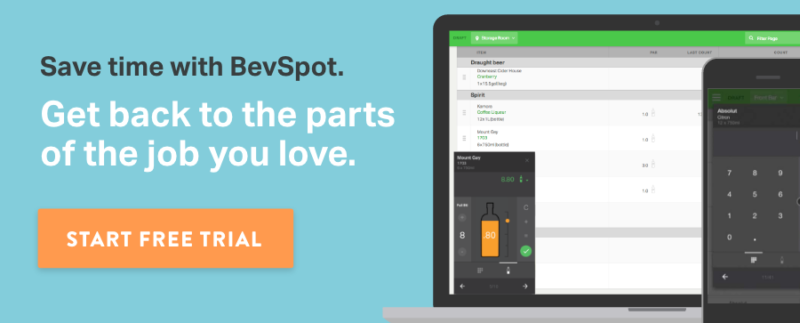
Schedule 15mins to chat with a product specialist
Start a FREE Trial Today! BevSpot offers full product education and account setup for all customers! No card Information needed!
Featured Products: 2016 Nightclub & Bar Show Tech Roundup
Founded in 2014 and backed by leading venture capital investors, BevSpot gives you the ability to streamline your entire bar management process. All of your processes can be conducted on any mobile device through this web-based software platform. Access real-time information on your item-level profitability and variance, optimize your drink pricing, and access analytics for your best and worst performing products. In short, BevSpot is an app that makes it much easier for you to make critical business decisions using real-time data, helping you to grow your business quickly…from anywhere. Cruise on over to their website to find out why in just a couple of short years the company has grown to 65 employees and over 300 clients throughout the US and select international markets…
Managing Sales and Profitability For Your Bar

It is possible to run a profitable bar and still spend time on parts of the job you love.
Sometimes, you just need a little help with the numbers. To manage a successful bar, you have to control the big costs: food, beverage, labor and overhead expenses like rent, equipment and licensing. It’s a multi-faceted process, and even with a bar inventory software to help control your profitability, it can be a tough job to ensure your bar or restaurant is financially successful.
Without a solid understanding of what’s going on behind the bar, it’s impossible to know if product has been sold, gone missing or been given away for free. You won’t be able to track pour costs or easily establish drink prices. You’ll start to lose control and, in turn, money.
We’ve discussed how to do liquor inventory and how to manage ordering and invoicing for a bar.
Now, it’s time for part three of this series:
How to manage your bar’s sales and profitability
In this article, we’ll discuss:
- How to control liquor inventory
- Managing the ordering and invoicing process
- Understanding your bar’s sales data
- How to calculate pour costs
- How to calculate drink prices
- Ways to monitor variance
Controlling Inventory
As a bar manager or owner, tracking your bar’s numbers will help you identify problems and know how to fix them. Properly counting and controlling inventory is the critical first step in understanding how your bar is doing financially.
Merely stocking your bar with the right alcohol isn’t enough. Taking inventory tells the bar manager exactly how much of each product a bar has used over a defined period of time. Doing so will allow you to check usage against the amount of liquor sold during an inventory period, which will lead to calculating your profit.
Usage is broken down by category (spirits, wine, beer), item type (tequila, vodka, whiskey), and brand (Grey Goose, Absolut, Bully Boy) in order to get an all-encompassing look at your bar’s performance. These numbers will be used to identify variance, calculate profit margins, make better purchasing decisions, and determine which products are and are not doing well. Learning how to do liquor inventory is the first step, where we understand the formula for inventory usage. Analyzing what these numbers mean comes next.
Your bar’s inventory process should be examined on a regular basis.
In order to protect profitability, those involved in taking inventory need to be properly trained in how to do it. This includes knowing how to:
- Estimate, or “tenth” the amount of liquid in each bottle
- Adhere to your bar’s specific inventory practices
- Properly record all numbers on spreadsheets, differentiating between bottles, kegs, and cases, and front bars, back bars, storerooms, etc.
- Identify issues like spillage, theft, or breakage of whole bottles
- Understand the consequences of incorrectly counted or entered inventory
Without inventory software, this task is always going to be a time-consuming and redundant one. But getting a grasp on your inventory process will make it easier. Things like setting pars are an important part of taking inventory, and will help for two reasons:
- Pars are a great way to speed up your inventory total calculations
- Pars help manage and set limits for how much inventory you’re ordering
Once you’ve identified your usage calculations for your inventory period, you can move on to understanding the numbers.
Ordering Product
Understanding your bar’s ordering habits and purchasing history will help you make more disciplined buying decisions when the time comes to call in your orders. How many times has a rep tried to talk you into buying new products that you don’t really need?
In order to gain a better understanding of the ordering process, you need to look at your sales figures to determine what works and what doesn’t. Creating a bar profitability matrix is an easy way to identify which products should and should not be on that order. We’ll cover this in our next post.
Observing fluctuating liquor prices and identifying the products that work for you are big parts of smart ordering. What kind of profit could you make on these products? Where would they compare to the price brackets of your menu? Here are some tips that might help you make orders for a more profitable bar:
- Finalize your order. Then finalize it again. Take a second to scrutinize every item and consider how it might affect your beverage program. Have your order clearly set out in front of you before you call it in.
- Organize your invoice history. Give yourself easy access to your purchase and spending history. Knowing what you’ve spent on certain products during certain time periods will help you create better orders for next time.
- Purchase to reduce your sitting inventory. Sitting inventory represents sitting dollars on your shelf, and by reducing this amount, you’ll reduce the chance of lost product and put dollars back in your pocket.
- Understand which products sell well and which don’t. This comes down to analyzing the PMIX report from your POS, and comparing it to your inventory history, which we’ll look at below. Once you’ve found your winning and losing products, you’ll be able to put together smarter orders.
Managing Sales Data
Improving your bar’s profitability comes down to knowing the numbers. And without the ability to analyze those that come from your POS system, you won’t be able to connect the dots with the rest of your beverage program. Hopefully, your bar is using a good POS that can run the right reports, but generally, the most important ones can be found on any system: the PMIX report, the menu item report, and the daily sales report.
After taking the numbers from your inventory and invoices, you’ll use these sales reports to identify how well your beverage program is performing. You should be able to see the item price, revenue, profit percentage, and sales volume of all your products. Let’s look at this in more detail.
Once you’ve identified the pour cost for each of your products, you can compare this to the drink’s sales volume, found on these reports. For every item on your menu—cocktails, beer (both bottled and draught), wine, and liquor—
You should be breaking down each menu item into the following sales data:
- Number of items sold
- Popularity, as a percentage of your entire beverage program
- Item cost
- Total cost of all such items
- Item sell price
- Item profit
- Total profit of all such items
- Total revenue of all such items
Take this data and sort each item into profit and popularity categories, and even further into classes: winners, losers, those that are too popular to get rid of, and those that need re-pricing.
If you’re looking for an easier way to see these results, calculate both the pour cost and sales volume for each item on your menu. The ones with a low pour cost and high sales volume are the winners, and the ones with a high pour cost and low sales volume are the drinks you’ll want to get rid of ASAP. Create a bar profitability matrix to see these results for every single one of your drinks. We’ll show you how to do this in our next post.
Calculating Pour Costs
The pour cost is an essential benchmark for your bar’s profitability. Monitoring and controlling a bar’s pour cost—which means keeping it as low as possible—is the difference between a profitable bar and a failing one. Depending on the popularity of a drink, a $1.50 difference in price could mean thousands of dollars in loss each month.
A drink’s pour cost is calculated by taking the cost of the product used and dividing it by the cost of the product sold. Or, more simply, your inventory usage divided by your sales.
POUR COST = INVENTORY USAGE / SALES
The average bar runs a 25-30% pour cost, but the aim, of course, is to decrease this as much as you can, a common goal being 20%. But what does a pour cost really tell us? It’s all about knowing the meaning of this critical figure—the numbers behind the number. Pour costs can be broken down into three factors:
- The cost of a drink—How much you pay for your product directly. This comes down to organized ordering and invoicing practices and being able to break down the cost of each ingredient that goes into a drink.
- The price of a drink—How much you sell it for, which comes down to properly pricing every drink on your menu (we’ll look at this next).
- Product loss—What you actually sold versus what you should have sold based on the amount of inventory used, otherwise known as your variance.
To understand these factors, you need to dive deeper into the other profitability issues in your bar. Let’s look at the next one.
Calculating Drink Prices
Pricing a drink menu is a complex thing, and what’s included on your menu will have a huge effect on those dollars. You need to take considerable care in developing an innovative and balanced menu for your bar or restaurant. ere are the things you’ll want to consider:
- Product variation—across all categories, brands, and drink types
- Catering to your clientele and neighborhood
- The latest industry beverage trends
- The labor involved in making each drink
- Pour cost across the menu
- Price range across the menu
A successful menu is built from well-priced drinks. If you want to run a profitable bar, it’s crucial to calculate every single aspect of each drink, down to the garnish.
To price a drink, all you have to do is divide the bottle cost by how many ounces are in the bottle. This gives you the cost per ounce, and you can build your drinks from there, ounce by ounce. Once you’ve determined the cost of a drink—by adding up the ounces of each ingredient—you can take that number and divide it by your desired pour cost percentage to determine the drink’s price.

Here’s a real example from one of our customers.
The Moscow Mule
4 oz. Gosling’s Stormy Ginger Beer @ $1.32 per can / 12 oz. = 0.11 per ounce = 0.44 total cost
1.5 oz. Green Mark Vodka @ $12.99 / 25.3 ounces = 0.51 per ounce = 0.77 total cost
Total drink cost = $1.21
Ideal pour cost = 12.95%
Drink price = $9.34
Drink price + tax = $10.00
Monitoring Variance
Variance, otherwise known as “shrinkage” or “lost product”, is one of the biggest detractors from a bar’s profitability. Variance is calculated by comparing the difference in product between the amount sold during a given period to the amount used during this period. In an ideal world, these numbers would line up perfectly, but the industry average variance rate hovers around 25-30%.
You’ll never be able to eliminate variance in your bar, but there are a few ways you can try to reduce it. These include:
- Purchasing to reduce the amount of sitting inventory you keep in stock at all times.
- Avoiding impulse purchases based on quantity discounts. It’s usually product you don’t need and money you don’t need to spend.
- Properly training staff. Waste, breakage, over-pouring, and theft are all contributing factors of variance. Training staff to understand the effect of these actions is the only way to fix them. Train staff in properly pouring drinks—use stoppers and even measuring pour spouts if they need to—and ask them to keep an eye out for signs of wastage, breakage, or theft in your bar.
- Closely monitoring all your numbers. If you’re properly tracking every aspect of your beverage program, you’ll be able to identify variance. It will be easier to watch your shrinkage levels and, in turn, find opportunities to decrease them.
To Summarize
Monitoring your bar’s inventory, purchasing, pour cost, variance, sales, and profitability numbers is a huge part of running a successful bar. But for any bar manager or owner, it can be a painful and time-consuming job to take on.
We’re here to make it easier, to help you run a better business.
Schedule 15mins to chat with a product specialist
Start a FREE Trial Today! BevSpot offers full product education and account setup for all customers! No card Information needed!
9 Essential Features For Your Bar’s Website
Effective website design is critical for marketing a bar or restaurant.
Today, most diners research restaurants online before visiting in person. They usually search when they’re on-the-go, looking for an easy-to-read page that can quickly tell them the essentials, while also giving them a feel for what your place is all about. While a professionally-designed website might sound desirable, a user-friendly, functional one is more important. Luckily, there are a bunch of cost-effective tools out there to help you design your own site.
SquareSpace, WordPress and Wix are some services we recommend, and even have themes specifically tailored to bars and restaurants to help you get started.
For even more features—like online menus, ordering and reservations—there are some great new premium services made specifically for restaurants and bars: BentoBox, Flavor Plate and Let’s Eat are just a few.
Regardless of the level of design you’re going for, here are nine essential website design features for your bar or restaurant.
1. Your Menus
These days, most customers want to see the menu before they go to a bar or restaurant. This means it’s essential to include all your menus online, including brunch, lunch, dinner, bar snacks, cocktails, wine list, draft list and any speciality menus, such as gluten-free and seasonal options.
Make sure your menu page is standard HTML. No one wants to take the time to download multiple PDF files. Also, HTML is easier for employees to edit, which is important for menu updates.
Keep in mind, most people searching for a place to grab a beer and a bite are using their mobile devices. This means, your menus should be optimized for mobile.
2. Your Contact Information
A hungry consumer isn’t going to take the time to search high and low for your contact information. If they can’t immediately find your address, phone number and hours, they’ll likely find a competitor’s site where this information is plainly visible.
It’s critical you display all of this information near the top of your website so customers don’t have to look hard to find it. Make sure your address is in a text that’s copyable, so people looking at your website can easily copy and paste the address to friends. And remember, most of your visitors will be on their phones, so ensure your bar’s phone number is a one-press button for calling.
If you want to make your restaurant even easier to find, add your business to Google Places. This way, if someone is in your local area and they search for bars or restaurants, your business will show up in the results, making it easier for people to find your establishment. You can also add a GoogleMaps widget to your page that shows exactly where your restaurant is on a map.
3. About Us/ Company Info
When you set up your ‘About Us’ page or fine tune your current one, we suggest you introduce customers to your business by telling them a short story. One of our customers, Papagayo, does a great job of this.
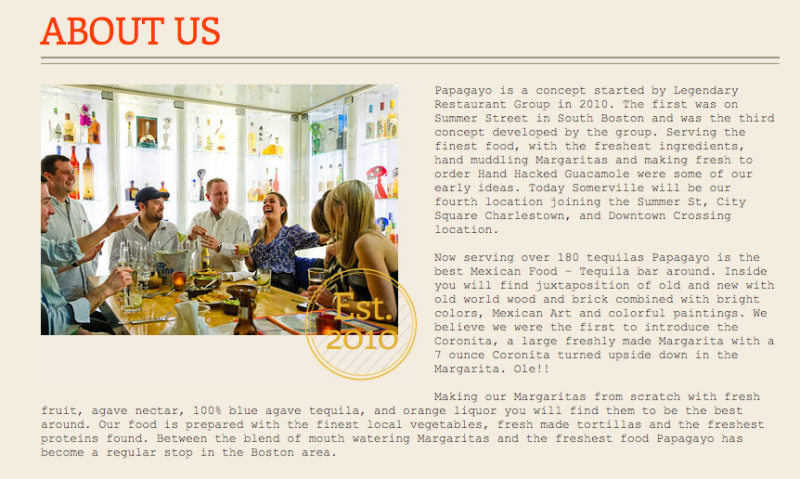
Not only is this a great introduction explaining how they started, what they pride themselves in, and what they’re known for, but this rich content also helps Google find their page. When Google is able to find a business’ page, the site will be rewarded by attaining a higher position on the search page.
If you run a smaller or single location establishment, you can add some credibility and personality to your ‘About Us’ page by including pictures and short bios of your staff members. Toro, another one of our valued customers, has pictures of the owner/chef and chef, and short bios that can be expanded to show more info. These text rich pages are also beneficial for SEO purposes.
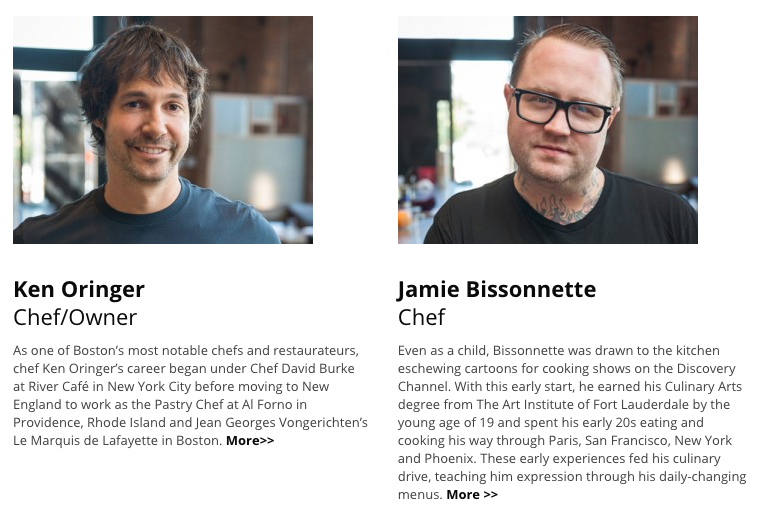
The ‘About Us’ section is also a great page to put any awards your establishment has won. Area Four displays their Boston awards along the bottom of their About Us section.

4. Social Media Integration
Customers like to connect with restaurants and bars via social media. They like to share pictures of decadent margaritas and delectable sliders. They want to know when you’re hosting trivia and what your newest cocktail looks like. Your website should have social follow buttons for your Instagram, Facebook, Twitter, and any other social accounts you have. This way, your site visitors can get to your social profiles with a click of a button. Shepard in Cambridge includes social sharing buttons across the top of their website.

This placement makes them easy to find. If you want to go a step further, you can include live feeds that preview what’s happening on your social media pages. Paparazzi, the Boston trattoria bar, includes a feed with their latest tweets at the bottom of their homepage, easily communicating small bits of information about their establishment and giving customers a preview of what content they’ll receive if they became a follower.
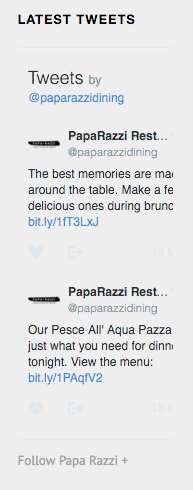
Also, consider adding an Instagram feed. Featuring a live photo-based feed will give you the opportunity to continuously showcase your restaurant’s food and beverage options as well as the customers who frequent your space.
5. Reviews
When customers search for a place to drink or eat, they usually head straight to review sites like Yelp, Google+, and TripAdvisor. In fact, 97% of consumers say they read reviews about local businesses. To encourage customers who visit your website to leave a review, be sure to include an easily recognizable button that brings your customers right to a review site. For example, Tavern Road includes a Yelp button at the very top of their homepage next to their social network icons. With just one click, customers are taken to Tavern Road’s Yelp page where they can easily make and read reviews.
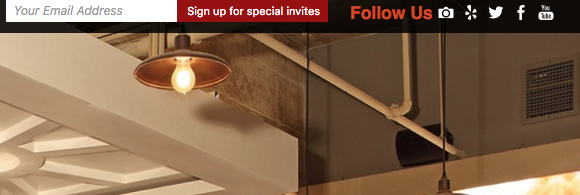
Another way to incorporate customer reviews on your website is to include review site widgets. We suggest you find a way to incorporate positive reviews on your website because 90% of consumers say positive reviews influence their purchase decisions. To create a scrolling showcase for their most excellent review, Trade Boston uses the TripAdvisor “Rave Reviews” widget.

If you’re curious which TripAdvisor widgets are available for your restaurant’s website, you can search for them here.
If you don’t want to bother with widgets, you can also manually pick and publish positive reviews to your website. Customers want to know what their peers think of your service, your atmosphere, and your food. Let your customers describe your restaurant for you by continuously updating your website with unbiased testimonials.
6. Reservations
When people visit your website, it should be incredibly easy to book a reservation. In a world of instant gratification, people are looking to quickly and painlessly plan a night out. If you only offer phone reservations, you might be losing customers who don’t feel like picking up the phone. If your restaurant offers reservations, you should provide an online booking option. By including this, you’ll decrease the number of phone calls during your busy hours, helping to better manage your staff’s time and allowing customers to make reservations when you’re too busy to pick up a phone or you’re closed.
You can also implement reservation widgets, such as Yelp SeatMe, OpenTable or Reserve, directly onto your website so customers can easily book a table without having to call anyone. Tavern Road includes an OpenTable widget on the sidebar of their homepage making it extremely easy for patrons to make a reservation.
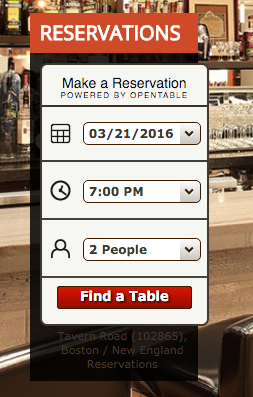
Five Horses Tavern in Somerville also uses an OpenTable widget, but in a different format.

If you want to keep your website more clean-cut, add an attention-grabbing button that takes users to a separate page for booking like Trade Boston does. However, keep in mind that this adds one more step than the previous two options.

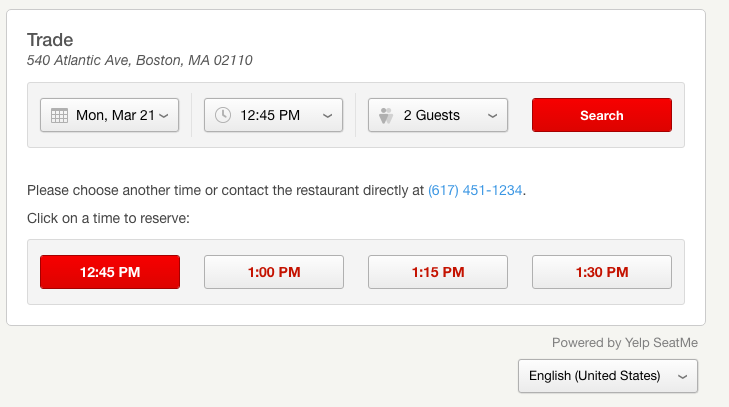
7. Photos
Before customers come in to dine, they want to know what the atmosphere of your bar or restaurant is like. They want to know if your establishment is fancy or casual, what the interior looks like, what the view looks like, etc. To meet this demand, you should include a good variety of high quality images on your website. Show them the inside decor, your outdoor seating (if you have any), the view from your best table, and your most aesthetically pleasing plate. Remember, consumers spend 2.5x more time on a business page with photos than one without. Plus, photos are an effective way to give people an idea of what to expect! As you can see below, Row 34 has a photo gallery that includes photos of their establishment as well as photos of beautiful dishes.
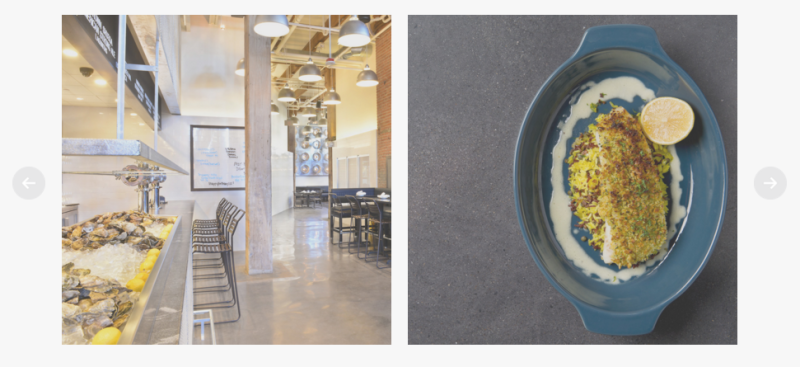
8. Mobile Functionality
Did you know, 97% of Google searches for the keyword “bars” come from mobile devices? People don’t plan too much ahead of time when it comes to where to drink. They’re constantly on the go and they’re in need of a quick access to an address, directions, a phone number, and hours.
Optimize your website for mobile users or risk losing customers. If someone visits your website on their smartphone, and he can’t easily click to call, locate you via Google Maps, or read your menus, you’ll likely lose him to a competitor with a more informative site. Google also favors mobile responsiveness. So, if you’re trying to improve your organic traffic, or you’d like to at least keep it at a steady level, you need to optimize your website for mobile.
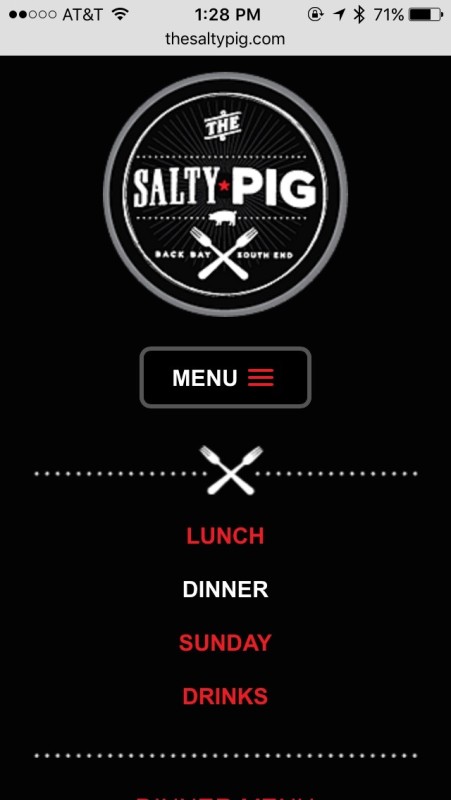
Above is an example of The Salty Pig’s mobile optimized website. They have easy to use drop down navigation, and their menus are individually listed in plain text.
9. SEO Strategy
Another way to boost your organic traffic is to establish some basic SEO (search engine optimizations) strategies. SEO helps search engines find your site and also rank your page’s relevance so it appears near the top of the search engine results. We realize you’re probably running a busy establishment, so you might not have a ton of time to spend on advanced SEO practices. However, by implementing a few basic practices, you can get more customers into your bar or restaurant.
First of all, make sure you have short, descriptive title tags for every page of your website. It’s a best practice to make sure they’re between 20 and 60 characters long. Include meta descriptions that describe each page in no more than 150 characters. Do not try to game the system by flooding your pages with the keywords because you want Google to rank you well. Google is onto these tricks, and your site will receive a penalty in the page rankings, which can take many months to recover from. Remember, customer experience should always come first! In addition, you can also register on restaurant directories like Urbanspoon, Yelp, Foursquare, and Yellow Pages. Or as Jeremie mentioned in the comments, you can get in touch with bar guides in your area such as WorldsBestBars.com or Liquor.com.
The Wrap-Up
You might be thinking these 9 steps to website optimization seem like a lot. Keep in mind, having these elements is essential for bringing more people into your establishment, especially in today’s highly competitive industry.
The hard truth is that 89% of diners research restaurants online, and 85% of people will leave a website if it’s poorly designed. Whether you’re building the website on your own, recruiting your tech-savvy friend, or hiring a third-party service, these website features are essential in order to be a valuable resource to potential customers. If you’re looking for a third-party service, we recommend BentoBox, a company that many of our customers use!
If you’re looking to revamp your website to bring in more foot traffic, you should also consider digitizing your bar inventory and ordering to boost your business. With BevSpot technology, you can access all of your bar’s data in real-time and grow your business faster—from anywhere.
Schedule 15mins to chat with a product specialist
Start a FREE Trial Today! BevSpot offers full product education and account setup for all customers! No card Information needed!
4 Classic Cocktails Made by Mixologists
Your favorite classic cocktails get a mixology makeover.
Everyone loves classic cocktails. And every bartender seems to have their own special twist on classic cocktail recipes—a dash of homemade bitters, a special garnish, an obscure modifier. But what if you knew the recipes for the ultimate, revamped mixology versions of these timeless drinks?
They don’t like to be called “mixologists,” but Josh Harris and Scott Baird of The Bon Vivants are certainly experts in the art of crafting cocktails. With a menu that changes every six months, their bar in San Francisco, Trick Dog, earned a 2015 James Beard nomination for Outstanding Bar Program and was included on the list of the World’s 50 Best Bars. So they know what they’re doing.
We sat down with Josh and Scott at the Charleston Wine and Food Festival to discuss innovative takes on classic cocktails. And you know what? Their “modernist” versions are incredible. Get the recipes below.
Advice From a Mixologist
“We wanted to share both the traditional versions of these classic cocktails and what we would do to ‘mixologize’ them,” says Scott. Sometimes, he explains, menus can be a little pretentious, and sometimes chefs and bartenders aren’t inclusive with the knowledge they have. He sends this advice:
- Think about the ingredients you need to include to create a balanced cocktail.
- But don’t alienate your guests with the way you display and describe these ingredients.
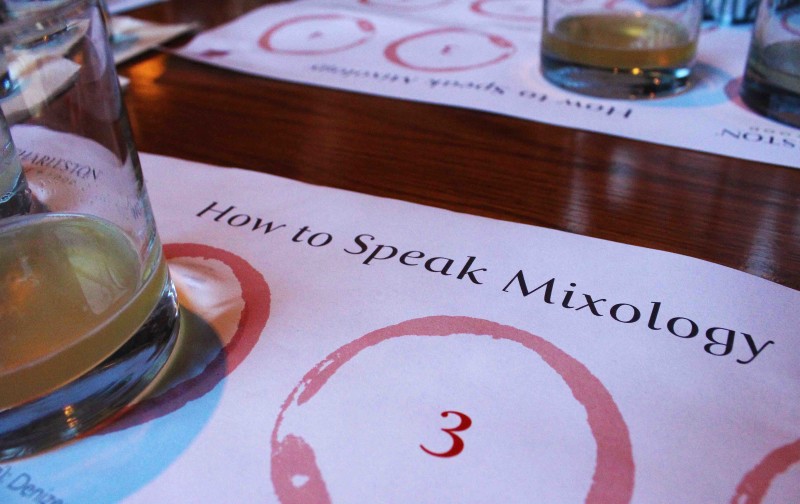
These days, consumers in this industry are more open-minded. People are more interested in mixology and visiting great cocktails bars. Scott explains how this is partly due to bartenders being more educated and seen as specialists. “Eight years ago, I made Cosmopolitans and Lemon Drops and that was it. It was a hard-earned fight to get an egg white into a drink, but times are changing.”
In the original definition of a cocktail, the definition that goes all the way back to Jerry Thomas’s book (the first drink book ever published in the U.S.: Bar-Tender’s Guide), a cocktail was a combination of spirit, sugar, and bitters. But things have changed since then, as Josh and Scott are about to show us with the modern versions of these classic recipes.
1. The Daiquiri
Here, we have two Daiquiris. Both have rum, lime, and sugar. The original Daiquiri and the modernist Daiquiri aren’t a comparison that Josh and Scott assert a preference over. “We think the original is one of the most delicious cocktails around. It’s not a statement of quality or uniqueness, we’re just showing what can be done,” says Scott.
The Classic Version
Daiquiris are old and classic cocktails, dating back to the Jerry Thomas Bar-Tender’s Guide, when he was making drinks in San Francisco after the Gold Rush in the same way we make them now—using good, natural, seasonal fruit and ingredients, and making our own spirits. This version is light and sweet.
- Denizen Rum
- Lime
- Organic Cane Sugar
The Mixology Version
This modernist Daiquiri takes the original definition one step further, with spirit, sugar, bitters, citrus, and water. It’s a little darker. “When you get into the mixology space of blending flavors, you’re striving for balance but you’re also adding these other weird, nerdy ingredients, such as an obscure modifier like the Amaro Montenegro,” says Josh. “Pour it on a big, fancy ice cube and it looks delicious and reads well on the menu, and you have a mixology Daiquiri.”
- Denizen Rum
- Lime
- Organic Cane Sugar
- Amaro Montenegro
The Daiquiri is a cocktail that Josh and Scott teach people to master because it easily transforms into other drinks. “A Daiquiri is the same as a Gimlet, only with rum instead of gin or vodka. You can go down this chain and the Margarita isn’t all that far from the Daiquiri.” Many of these cocktails can use spirits interchangeably.
Cocktail types vary across the world, but a Daiquiri is usually always going to be a Daiquiri. “You might see coconut sugar or cane sugar instead of white or brown sugar, but those simple substitutes make huge flavor changes,” says Josh.
It’s important to be able to identify and decipher these things on cocktail menus. In bars today, you’ll see a drink made of rum, cinnamon syrup, and lime, but it’s not called a Daiquiri. Scott says they see this variation with Manhattans and Old Fashioneds all the time. “People like to put bourbon or rye with sweet vermouth and some kind of bitters and call it a ‘house whiskey cocktail’, but it’s just a variation on a Manhattan.”
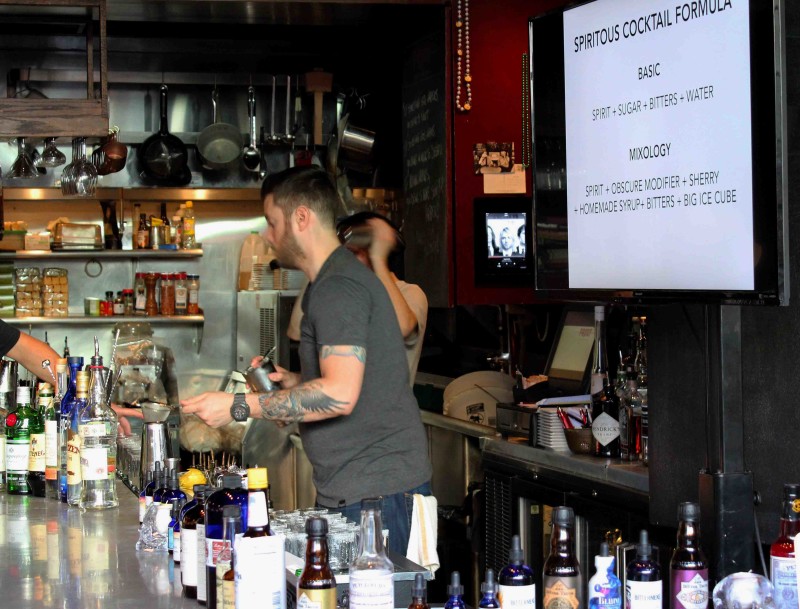
2. The Margarita
“I like my Margarita on the rocks, which doesn’t last long if it’s a good Margarita, but gives the ice a good little melt,” says Josh. He tell us why the Margarita is one of the hardest drinks to make. “It’s balancing the flavor of the tequila, the amount of orange liqueur you’re using, and the lime, which change with the seasons (they can be very acidic and bitter during winter), so you have to play with all that to balance it,” which, as we know, is the secret to the perfect cocktail.
The Classic Version
- Milagro Tequila
- Cointreau
- Lime
- Salt
The Mixology Version
- Ocho Reposado, which is very agave forward
- Ancho Reyes Chile Liqueur
- Lime
- A small amount of sugar (because the Ancho isn’t as sweet as cointreau)
- Dehydrated and ground up vanilla beans and orange zest on the rim
Josh explains the difference between the recipe for the original Margarita and something that’s now internationally recognized as a “Tommy’s Margarita”. Tommy’s is a restaurant in San Francisco, where the now-owner’s father, Julio Bermejo, was responsible for all the tequila coming into the U.S.. “He created a Margarita that now, to mixologists like us, is nothing crazy—instead of tequila, triple sec (or cointreau), and lime, he used tequila, agave nectar, and lime. And this is a major distinction.” Josh explains that even though it tastes different, it’s still a Margarita. “It’s easier to balance and has a different mouth-feel. We’ll go all the way around the world and see it on cocktail menus.”
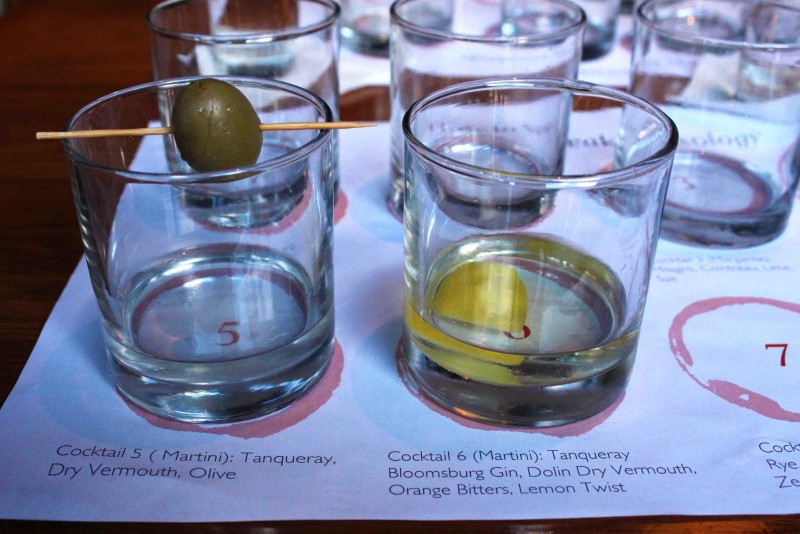
3. The Martini
Time for two more drinks—two versions of the Martini. It’s a sophisticated, strong, and sexy cocktail, and while the history of how the Martini came about is much debated, the recipe today rarely varies.
The Classic Version
This first one is a guilty pleasure in the bartending world, and, surprisingly, the best hangover cure you’ll find. “Shake it up real cold,” says Josh.
- Tanqueray
- Dry Vermouth
- Olive
The Mixology Version
This version is a throwback to the classic-style Martini, but with a mixologist’s twist. “It has a lot of vermouth in it, and the gin is more flavorful and herbal. It also has bitters and lemon zest to brighten it up,” says Scott.
- Tanqueray
- Bloomsburg Gin
- Dolin Dry Vermouth
- Orange Bitters
- Lemon twist
4. The Old Fashioned
The classic version of the Old Fashioned is one of the most trending drinks right now. The Old Fashioned goes by the original definition of a cocktail—spirit, sugar, and bitters—and it can be made with either bourbon or rye. “This first one, the classic version, is from the 18th century. It’s the drink that every single mustache-twisting bartender wants to make you right now,” says Scott.
The Classic Version
- Bulleit Rye
- Angostura Bitters
- Orange and lemon zest
The Mixology Version
- Bulleit Bourbon
- Banana liqueur
- Brown sugar and cinnamon simple syrup
- Star Anise
- Topped with soda
Scott believes this recent obsession with the Old Fashioned comes from the trust level people have built with bartenders, the media presence surrounding the resurgence of whiskey and craft whiskey distillers, and consumers’ growing understanding and comfort levels. “Regardless of whether they know any other cocktail, people know if they walk into a cocktail bar and see bartenders who look like they know what they’re doing, they can ask for an Old Fashioned and there’ll be a real good chance that the bartender respects them, they respect the bartender, and they’re going to stay a while. We see this happen in a lot of bars.”
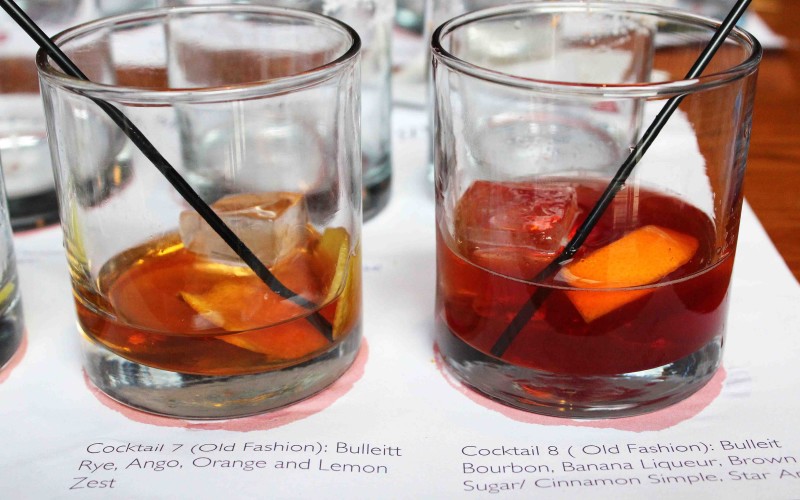
The Magic of Bartending
We asked Josh and Scott if they think bartender and consumer behavior trends have changed. “That kid with the Red Bull and vodka? That’s still about 15% of the market share,” says Josh. He explains how this kind of bartending—mixology as a craft—is getting more popular, just like people’s interest in food and cooking is getting more popular. “There is actually substance to these jobs; you have to learn and practice things, and if you don’t, you’re not going to succeed.”
“I’ve always said that this is the best job in the world because you can be as nerdy as you want and the learning never stops: the history, the flavour, the way it’s made… you can always keep going and improving,” says Scott. “But then the moment you finally get a guest in front of you, you forget about everything. It’s all about them and it’s personal. And this combination of things is what draws me to this industry.”
For more articles about mixing killer classic cocktails and other industry news, head to our industry culture page.
Looking for some advice on running the ultimate cocktail bar? Get your free eBook here:
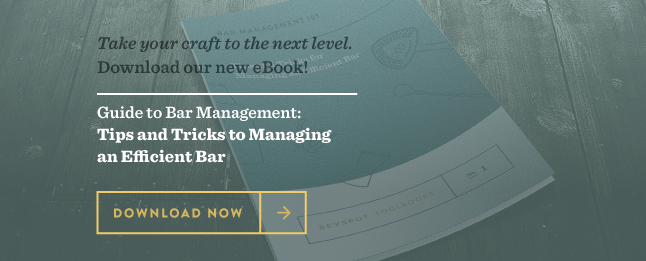
Schedule 15mins to chat with a product specialist
Start a FREE Trial Today! BevSpot offers full product education and account setup for all customers! No card Information needed!
St. Patrick’s Day in Boston at The Whiskey Priest
St. Patrick’s Day in Boston
With St. Patrick’s day right around the corner, I’m already planning where I’m going to celebrate. I’m sure I’m not alone. The day is marked as the 4th most popular drinking day in the year and Boston was rated the best place to celebrate St. Patrick’s day in the country!
Boston boasts the most concentrated Irish population for a city – a whopping 20.4%! We’re deemed to have the most St. Patrick’s Day traditions, including our annual St. Patty’s Day parade, which marches down the main strip of South Boston (Southie, for us locals). We also have a large number of Irish pubs and restaurants that we easily fill to max capacity with a sea of green. Not only is this a day for drinking, but many bars also have big plans for St. Patrick’s Day, such as live Irish bands, bar crawls, green beers, and contests.
St. Patrick’s Day is a huge day for bars, with over 37 million Americans planning to celebrate at a bar or restaurant. Beer sales are estimated to reach over $255 million this year!
Wondering where Bostonians are headed this Thursday? With our recent warmer weather, the Whiskey Priest, a popular Irish pub on the ocean, is sure to be a hot spot. Located in the Seaport, the bar features old Irish favorites, an extensive selection of new world pub dining, 32 beers on draught, and 138 whiskeys. Plus, it fits 360 people and has a water-facing roof deck!
With St. Patrick’s Day a few days away, I sat down with Patrick Dolan, one of Whiskey Priest’s bar managers. Here’s what he had to say about his time at the Whiskey Priest and what it’s like to run an Irish pub in the most Irish city in America.
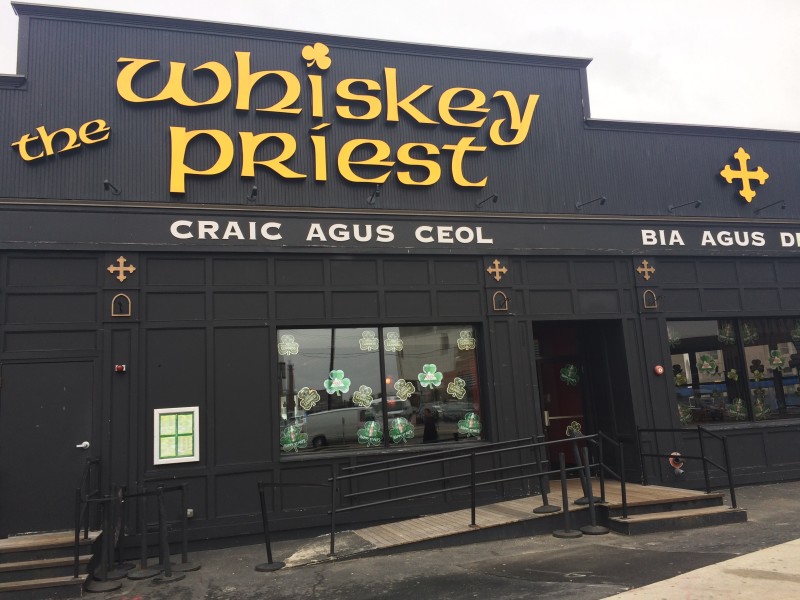
What brought you to the beverage industry?
“Being from Ireland, it was a natural first step into the working world. I started working the bar when I was 16 at an old style country pub. Lots of fussy old men and their pints of Guinnesses. They were so fussy, when I started they wouldn’t let me pour them a pint!”
How long have you lived in Boston for?
“I was actually born here. I lived in Revere until I was four, and then my family moved back to Ireland. I recently returned to Boston three years ago from County Cork. The owner of Whiskey Priest, John Cronin, has a place called Soho Bar and Restaurant, and I worked the bar there for three years. I realized I wanted a change, and I wanted to get back to my roots, so I got on a plane to Boston. Once I got here, I got John’s phone number and got in contact with him. He set me up at the Whiskey Priest as a bar manager, and I’ve been here ever since.”
How does being Irish translate into your day-to-day here?
“I like to think I bring a bit of Irish flair, which is kind of tough because there are so many generic Irish places around these days. We actually decided we’re going to change up the menu and bring back some traditional Irish food. We sort of shifted to more Americanized pub food, like chicken tenders and burgers. A lot of our menu simply has Irish placeholders now like Irish Cheese Fries or Gaelic Sliders. We recently found an old copy of the menu that was really traditional with dishes like pig’s feet. That’s a little extreme, so we’re going to try to find a happy medium.”
What’s your favorite Irish dish?
“I love a good Irish breakfast with black and white pudding and some beans. People come in here sometimes looking for it, but we don’t serve breakfast. My favorite Irish dish we serve here right now is the Shepherd’s Pie.”
What’s your favorite part about this city?
“I love the music scene here. Right now, I’m really into jazz music. I love places like the Beehive. Also, Wally’s Cafe is hands down the greatest place I’ve ever been in my life.
What’s your favorite drink to make?
“Manhattans right now. I’ve revamped our whiskey list and learned a lot about whiskeys in the process. We’re actually doing a barrel aged manhattan right now.” (Side note: I tried one and it was delicious)
What’s your favorite drink?
“Aviation, I could be cliche and do a Jameson and Ginger but…”
Tell me your funniest bar story.
“So this happened before I had the bright idea to get stoppers for the bay windows. The first summer I worked here, a guy took a running start down the hallway and launched himself out the window into the water in the middle of a crazy Saturday night. We all had to run around to the docks and we ended up pulling him out the water. We told him the cops were on their way. He said his friends had dared him $500, and that he was a teacher and we shouldn’t ruin his life. We just said “No one pushed you out the window. Guess you have to use your $500 for bail money.”
What’s your favorite thing about working here?
“I love the team we have. We’re a big happy family here. I think that’s important for a bar that gets as busy as we do. I don’t think we’d be able to handle it as well as we do if we weren’t so close.”
What is St. Patrick’s day like here?
“That’s an interesting question. I want to just say it’s a free for all. I don’t know, I think everyone just embraces their Irishness that day. People who would never drink a pint of Guinness or an Irish Car Bomb in their life will have 4 or 5. It’s funny to watch the effect it has on people. This year should be different, because this is the first year we’re staying open late on Sunday after the parade. It will be interesting to say the least.”
Do you have any specials for St. Patrick’s day?
“We’re expecting a lot of people this year. We’re having 100.7 WZLX and Chuck Nowlin come from 5-7pm to DJ and broadcast live. They’ll be giving out radio prizes like CBS golf cards, gift certificates to the High Octane Harley, and an overnight stay at Foxwoods Resort Casino. After that, we’ll have another live DJ come in. We’re also going to have a special food menu that features some traditional Irish cuisine like corned beef sliders, corned beef dinner, and Shepherd’s Pie. Plus, we’ll obviously have plenty of Guinness.”
What’s your thought on green beer?
“I think it’s just too much. It’s outdated. Green food coloring in your beer? Who wants that?”
How does St. Patrick’s Day in Boston compare to other places you’ve celebrated?
“Since I started working at the industry, I’ve always been behind the bar, because it’s just a big celebration that needs staffing. In Ireland, St. Patrick’s Day is similar to here. People just go to a parade and drink all day. Honestly I think America does it bigger than Ireland. Parades are bigger and more extravagant.”
You have a lot of whiskeys, which one is your favorite?
“That’s a very tough question, we have 138. I think my favorite is Michter’s Rye Whiskey. It’s the new one on the menu, and it’s absolutely delicious.”
Do you read any industry blogs?
“I subscribe to Liquor.com, and I read those emails when they come in. I should really subscribe to BevSpot’s blog, I’m going to right after this interview. I also see things my friends post on Facebook. I have bartending friends from around the world, who post interesting articles. For instance I found out that pop-up cocktail bars are a big thing back home now apparently.”
Do you have any advice for people aspiring to be bartenders or bar managers?
“You really need to have a passion for what you’re doing. You need to concentrate on giving the best that you can and knowing that whatever happens on a crazy Saturday night isn’t personal. People get aggravated, and you need to keep cool, keep calm, keep your head down, and keep working. Also, just have fun! If people see you having a good time, they’re going to have a good time too. I would dance behind the bar back home a lot. When people were freaking out, I’d be the person dancing around not letting the stress get to me.”
Any suggestions for looking to celebrate St. Patrick’s Day here in Boston?
“The Whiskey Priest, of course! The Guinness will be flowing and it’ll be a great time.”
As you can see, The Whiskey Priest is definitely the place to be to celebrate St. Patrick’s Day. If you don’t have to work the bar yourself, head on over, say hi to Patrick and grab a Guinness!
Planning on serving/drinking some beer to celebrate St. Patrick’s day? Check out our Glassware Guide to make sure you use the correct glass.
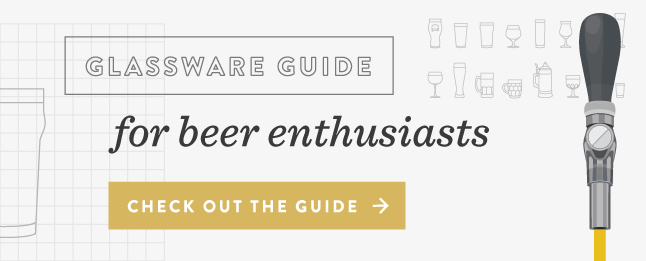
Schedule 15mins to chat with a product specialist
Start a FREE Trial Today! BevSpot offers full product education and account setup for all customers! No card Information needed!
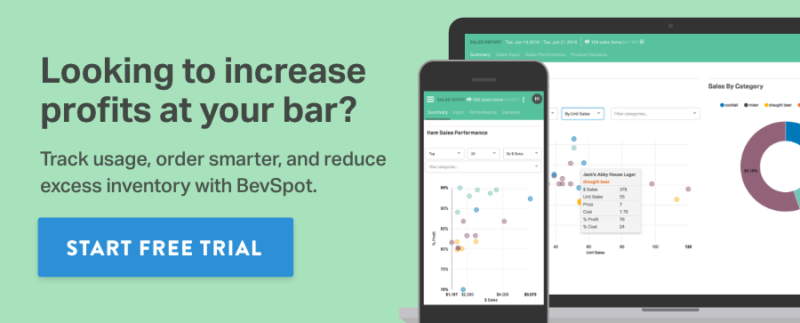
5 Common Bar Management Mistakes to Avoid
Have you made these bar management mistakes?
The bar and restaurant industry is a risky place to be. Over 60% of new establishments go under in their first year; 80% by their fifth year. But we’re all still here because we love it.
Bar managers build successful businesses and call the shots on every aspect of a bar’s operations. Beverage directors develop innovative cocktail menus and create drinks for their guests that establish a love affair with completely new flavors.
But running a bar is hard work. Being responsible for so many aspects of a business is a lot of pressure—overlook the smallest thing, and you could see the numbers come crashing down in front of you.
That’s why we’re here. We’re helping bars and restaurants streamline operations so that you can spend more time on the important things.
It’s a bumpy ride. Here are some of the bar management mistakes you need to avoid along the way.
-
Poor Employee Management
Successful business management starts with the staff—you can’t run a good bar without them. Your establishment will live or die based on how your customers are treated and whether or not they feel comfortable in your space.
This responsibility falls directly on the shoulders of your employees, but it’s your job to provide them with the knowledge, ability, and tools to do so. Support your staff and they, in turn, will support your customers.
This means:
- Adequate training in every aspect of bar operations. Don’t just teach your employees how to do something, explain why it’s important and what impact it will have on the business. Properly trained staff will not only delight your customers but will help avoid shrinkage through loss of product, like theft and over-pouring.
- Set clear goals and expectations, and ask for your employees’ input when setting them.
- Irresponsible or unorganized scheduling will upset staff members. Talk to your team if you’re planning major schedule changes, and never spread them too thin.
- Don’t ignore internal problems—they won’t just disappear. If something’s going on with one of your staff members, you need to address it.
- Build a fun, exciting, and supportive work culture. Your employees will enjoy their jobs and reward you for it.
- Poor communication is the root of many business problems. Mistakes like failing to give proper feedback or insufficiently explaining tasks will leave staff feeling lost.
Download your free Guide to Bar Management eBook.
-
Losing Touch With Industry Trends
Are you aware of what’s popular in the industry? Do you know what cocktails people are looking for right now? Do you know why Old Fashioneds, Mezcal, Sour Beers, Nitro, Bitters, and tapped cocktails are trending?
One of the most common bar management mistakes is losing touch with industry trends, and this is an automatic loss of business. People love to get a taste of what’s hot, and if you’re not stocking it, they’re not staying. The easiest way to stay up to date is by reading relevant publications and following popular social media channels. We recently compiled a list of our favorite industry blogs—check out this roundup of the top 20 bar industry publications to follow.
It’s also a good idea to visit online forums (we frequent industry groups on Linkedin) and attend industry events in person in order to expand your network and stay in touch with what’s new. We recently attended the Nightclub and Bar Show in Vegas, and it was a wild couple of days (and super educational).
-
Poorly Developed (and Priced) Menus
A menu is one of the most significant and revealing aspects of any bar or restaurant. Often, we see beverage directors develop exciting and innovative menus only to neglect them during the following months, or even years. A menu carries massive weight when it comes to an establishment’s profitability and success—the nuances of your menu will have a substantial affect on your numbers.
Here are some important things to consider when designing and pricing a bar menu:
- Stock your bar with not only the right product, but the right variation and mix, while also keeping it simple enough to not overwhelm guests.
- Cater to both the style of your bar and the preference of your neighborhood and clientele.
- Consider the labor involved with each menu item, especially cocktails.
- Properly price each aspect of every drink, and ensure there’s a price balance across the menu, i.e. some items can be sold at or below cost, provided other items can make up the loss by being priced above the typical mark-up.
- Constantly monitor both top-performing and bottom-performing products, and where they’re situated on the menu.
- Consider including an additional happy-hour menu, or a rotating daily menu.
- Calculate and monitor your pour cost at the highest level of scrutiny.
When designing and updating your menu, allow your staff to submit cocktail recipe ideas. Narrow down the list to a selection of your favorites, and taste and tweak the recipes. Build your recipes with as many fresh, high-quality ingredients as you can, while also focusing on minimizing waste and maximizing profitability. With beer, put together a good mix of local beers, domestic beers, and international beers that cover each beer type. Your wine list will depend heavily on your menu, clientele, and price points.
-
Insufficient Marketing Efforts
Marketing your bar is more than just creating a Facebook account, and this is one of the most common bar management mistakes. Publishing irresistible #foodporn is important, yes, but marketing your bar is a multifaceted process that requires significant dedication.
- Commit to social media. Building a presence online is harder than it seems. It’s a platform to promote your discounts and events, of course, but it’s also a place to develop a strong and trustworthy brand identity. You should be connecting with your customers and potential customers and projecting an image of what your establishment is really about. And, of course, posting irresistible photos of your latest drinks and dishes is important. Use social media management tools like HootSuite and Buffer to maintain an active presence while saving time.
- Offer loyalty programs and discounts. These should be distributed both externally—in your local area and on social media—and within your bar—on the menu and through your staff.
- Create an email newsletter. This is another channel for you to extend your brand identity, reach out to consumers, and promote discounts and deals.
- Set up a Google+ account. When you search for a business on Google, Google Knowledge Graph pulls up relevant contact and business information in the right sidebar, so registering your business with Google+ creates more online visibility and trust.
- Connect with industry experts. Reaching out to industry bloggers is a great way to get your name out there. You can offer special discounts in exchange for promotion of your establishment, or offer to write an “industry expert” guest blog post for their publication.
- Sign up to discount websites like Groupon and LivingSocial, and create accounts on delivery sites like GrubHub (if it’s appropriate).
Guide to Marketing Your Bar or Restaurant
-
Ignoring Your Liquor Inventory
From counting inventory and ordering alcohol to calculating your pour cost, understanding correct inventory practices is crucial to running a successful bar. As a bar manager, if you don’t develop and uphold solid processes for each stage of the inventory process, your numbers are going to suffer.
These are the most crucial elements to inventory management. If you’re not on top of them, your bar is in trouble:
- Accurate and efficient usage counts
- Fast ordering and organized invoicing
- Setting accurate pars
- Monitoring pour costs
- Calculating and lowering variance
- Minimizing sitting inventory levels
- Identifying top and bottom-performing products
- Using your POS to monitor sales and profitability numbers
If you don’t control these aspects of the inventory process, your variance could grow out of control, you’ll be 86-ing more often, and your sales and profitability could take a huge dive. Teach your staff how to correctly monitor liquor and pour drinks. Organize your invoice history. Use your POS system to compare sales numbers to inventory counts. It’s not the most enjoyable aspect of bar management, but liquor inventory could very well be the most important.
Here at BevSpot, we’ve developed inventory software that’ll take care of this for you and fix your bar management mistakes.
We also have bar management resources that’ll get you on the right track, like free eBooks, case studies and, of course, our famous drink price calculator.
Schedule 15mins to chat with a product specialist
Start a FREE Trial Today! BevSpot offers full product education and account setup for all customers! No card Information needed!
How to Price a Cocktail Menu
How to Price a Cocktail Menu
When figuring out how to price cocktails, balance is key. You don’t want customers to complain that your cocktail menu is too pricey, but you also don’t want to give your drinks away for free. Customers want value for their dollar, but you also have to cover expenses like rent, equipment, and labor while still making a profit.
Start Your Free Trial With Bevspot Today!
To achieve a balance, you should take careful consideration when deciding how to price cocktails for your bar. Just like our 15-step guide on bar managing, here are our 5 steps to pricing drinks:
1. Determine how much each drink costs to make
The first step is to figure out exactly how much each drink costs you to produce. This means you need to price out a drink’s individual ingredients and add them together to get the total cost per drink. Here’re a cocktail recipe pricing example from a popular Boston bar:
The Walnut
1.75 oz Old Overholt Rye = $0.78
0.5 oz Nux Alpina Walnut Liqueur = $0.89
0.75 oz Meletti Amaro = $0.42
1 dash Angostura Bitters = $0.02
1 dash Regan’s Orange Bitters = $0.02
Total drink cost= $2.12
Now that you know how much this drink costs to make, you can determine what menu price will bring you a reasonable profit.
2. Use industry standard (or lower) pour cost percentage
Pour costs, also known as a bar’s “percentages,” represent the cost of the product used as compared to the cost of the product sold. To calculate pour cost, take your total inventory usage (or cost of goods sold) and divide it by your total sales:
Pour Cost = Inventory Usage/Sales
Pour costs are a crucial gauge for bar profitability. As you know, running a bar can be costly. Keeping your pour costs as low as possible could make the difference between failing and succeeding.
The industry standard pour cost is 20%, or ⅕ of your drink price. As a bar manager or owner, your goal is to bring your pour cost down to 20% or below.
For a 20% pour cost on The Walnut→ $2.12 x 5 = $10.60
If you want a better idea of how important pour cost is, think about it this way. Imagine your bar and the bar next door sell about $1,000,000 each year, but your bar runs a 30% pour cost and the bar next door runs a 20% pour cost. Even with the exact same sales and the same client base, you will make $100,000 less in profit each year.

3. Factor in variance
A 20% pour cost is a great goal to aim for, but it doesn’t factor in variance (lost product or shrinkage). Although lost product doesn’t directly affect sales, it factors into usage and therefore, pour cost. Because industry shrinkage is around 20%, you’ll want to factor that anticipated shrinkage into your pricing in order to have a cushion. This means you should really aim to price your cocktails at an average pour cost of 16.67%.
With this in mind, you should ideally price The Walnut at $12.72. You can round this number down to $12.50 or up to $13.00 to make your pricing more straightforward.
4. Consider location, client base, and client preference
If your bar is located in a low-income or rural area, you probably shouldn’t price your drinks at $14. However, if you’re located on the main strip of major city, you’re likely paying a higher rent and your establishment is probably surrounded by other pricey establishments, so a loftier pricing scale might be acceptable.
You also have to factor in your client base. If you’re located downtown, but you’re close to a college campus, you’ll likely have to adjust your prices to match with the strapped-for-money, college crowd. Similarly, if you’re located next to corporate finance buildings, you might be able to bump up your drink price by a dollar or two.
Lastly, your clients’ preferences should be taken into consideration. If you look at your customers and sales history and discover that 50% of your sales are in spirits and your beer program is the least profitable, you can probably achieve a lower pour cost in your spirit program compared to your beer and wine program. To get an average pour cost of 16.67%, you can test out a 10% pour cost on spirits, a 20% pour cost on wine, and a 27% pour cost on beer.
It’s important to be aware of these three factors, but if you can’t initially nail down the correct pricing, don’t stress. Sometimes it takes some trial and error to get it right. Just make sure you’re tracking your bar’s sales data, so you can easily see what pricing is working and what isn’t.
5. Evaluate the competition
When you price your drinks, consider other bars in your area. Customers will most likely compare your pricing to other bars in proximity. If a competitor called Iguana Mike’s across the street has decent $8.00 margaritas, there’s a good chance your similar $13.00 margarita isn’t going to be a best seller. A $5.00 difference might even be an extreme example, customers will likely notice even a $1.00 difference.
To properly price your cocktail list, you need to understand what your competition is offering and charging. Look around you. If the place across the street has a similar ambiance, quality of ingredients and service, drink presentation, and entertainment, your drinks should be priced more closely to theirs.
However, if your establishment is of noticeably higher quality, higher drink prices may work well. It’s all about what customers are willing to pay. In the above example, Iguana Mike’s has a similar margarita that costs $5 less than yours. Because you’re offering the same product for $5 extra dollars, customers will likely head across the street. However, if your bar has a classier ambiance, and your margarita is masterfully crafted with fresh high-quality ingredients and expertly prepared with a black salt rim and a pineapple slice, it might be worth the $5 extra dollars.
The wrap-up
As you can see, there are a lot of factors to consider when pricing your cocktail menu. To determine the right balance, you need to carefully consider each element and do the math!
We know, remembering all those conversions can be a hassle. To make it easier, we created a Drink Price Calculator to take care of all the math for you so you can accurately price drinks faster! To make it even easier, the BevSpot software has a built in ‘Price & Costing Tool’ that speaks with your POS system to give you valuable insights about the data behind your bar.
Want to learn more about how BevSpot can boost your beverage program? Get in touch with one of our product specialists to find out how we can help.
Schedule 15mins to chat with a product specialist
Start a FREE Trial Today! BevSpot offers full product education and account setup for all customers! No card Information needed!
